An Overview of the Design of Metal-Organic Frameworks-Based Fluorescent Chemosensors and Biosensors
Abstract
:1. Introduction
2. Detection Mechanisms of MOFs-Based Fluorescent Sensing Platforms
3. Chemosensors
3.1. Inorganic Ions
3.1.1. Metal Ions
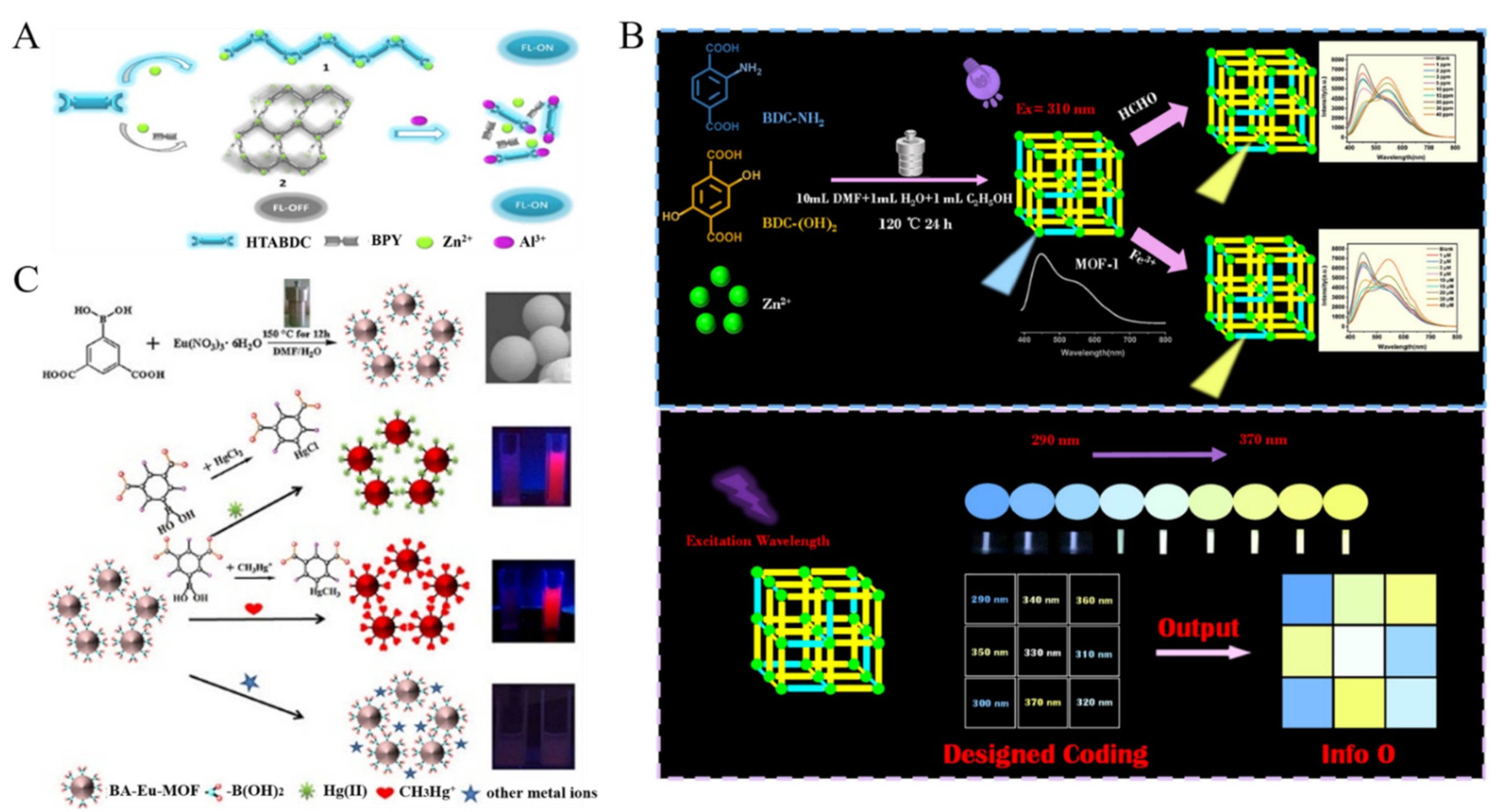
3.1.2. Anions
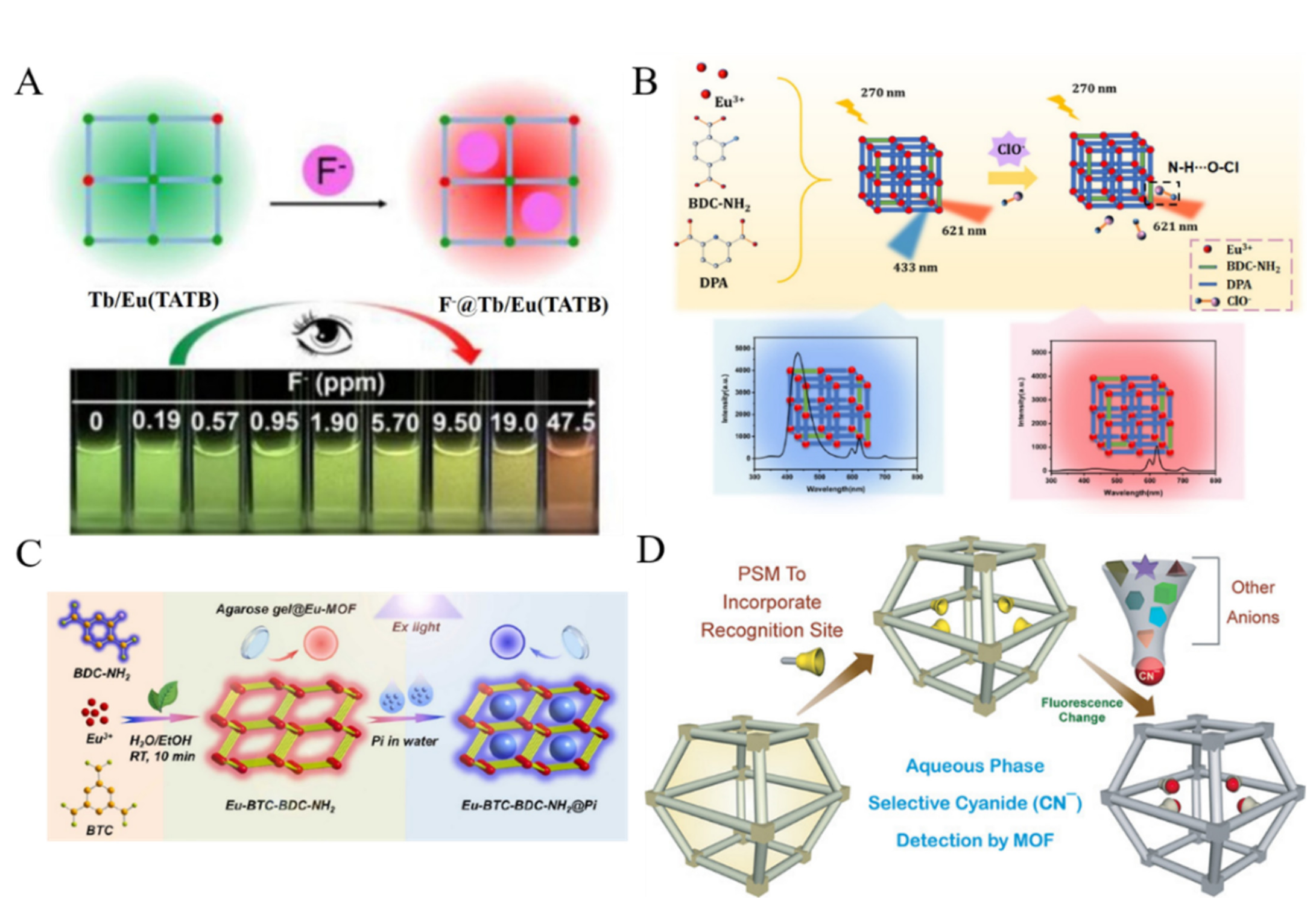
| MOFs | Targets | Linear Range | LOD | Ref. |
|---|---|---|---|---|
| Cd-MOFs | Cr3+ | 0~3 mM | 0.164 μM | [80] |
| UiO-66-NH2 | U(VI) | 0~1.2 μM | 0.08 μM | [81] |
| UiO-66(OH)2@PCN-224 | Cu2+ | 0~10 μM | 0.068 nM | [63] |
| Porphyrinic Zr-MOF-525 | Cu2+ | 1~250 nM | 220 pM | [64] |
| Porphyrinic PCN-222-Pd(II) | Cu2+ | 0.05~2 μM | 50 nM | [65] |
| Eu-MOF | Cu2+ | 1~40 μM | 0.15 μM | [66] |
| CDs@Eu-MOF | Cu+ and Cu2+ | 0.5~20 μM and 0.5~20 μM | 0.22 and 0.14 μM | [67] |
| CCM@MOF-5 | Al3+ | 0~0.33 mM | 2.84 μM | [68] |
| AIE-active Zn-MOFs | Al3+ | Not reported | 3.73 ppb | [69] |
| Tb-MOFs | Fe3+ | 0.33~33 μM | 0.936 μM | [74] |
| Tb-MOFs | Fe3+ | 0~100 μM | 0.35 μM | [71] |
| Zn-MOFs | Fe3+ and HCHO | 1~40 μM and 1~40 ppm | 0.58 μM and 370 ppb | [75] |
| RhB@Zr-MOF | Fe3+ and Cr2O72− | 0.01~1 mM and 1~100 μM | Not reported | [72] |
| Eu-modified Ga-MOFs | Hg2+ | 0.02~200 μM | 2.6 nM | [78] |
| BA-Eu-MOF | Hg2+ and CH3Hg+ | 1~60 μM and 2~80 μM | 220 and 440 nM | [79] |
| BODIPY@Eu-MOF | F−, H2O2 and glucose | 0~30 μM, 0~6 μM and 0~6 μM | 0.1737 μM, 6.22 nM and 6.92 nM | [91] |
| Tb3+ and Eu3+-MOFs | F− | 0~1.9 ppm | 96 ppb | [92] |
| Eu-MOFs | Eu3+ and F− | 0~7.4 μM and 0~515 μM | 0.2481 μM and 1.145 μM | [93] |
| Eu-MOFs | HClO | 1~20 μM and 20~40 μM | 37 nM | [95] |
| CDs/CCM@ZIF-8 | HClO | 0.1~50 μM | 67 nM | [96] |
| Eu-MOFs | PO43− | 0.1~10 μM and 10~50 μM | 0.07 μM | [100] |
| M-ZIF-90 | CN− | 0~0.1 mM | 2 μM | [102] |
| UiO-66@COFs | PO43− | 0~30 μM | 0.067 μM | [97] |
| Tb-modified Zn-MOFs | PO43− | 0.01~200 μM | 4 nM | [99] |
| Eu-MOF@Fe2+ | BrO4− | 0~0.2 mM | 3.7 μM | [101] |
| BA-Eu-MOFs | Cr2O72− | 0.1~3 μM | 0.58 μM | [103] |
| Zn-MOFs | Cr2O72− | 0.3~20 μM | 0.09 μM | [104] |
| RhB/UiO-66-N3 | H2S | 0.1~4 mM | 82.4 μM | [106] |
3.2. Small Organic Molecules
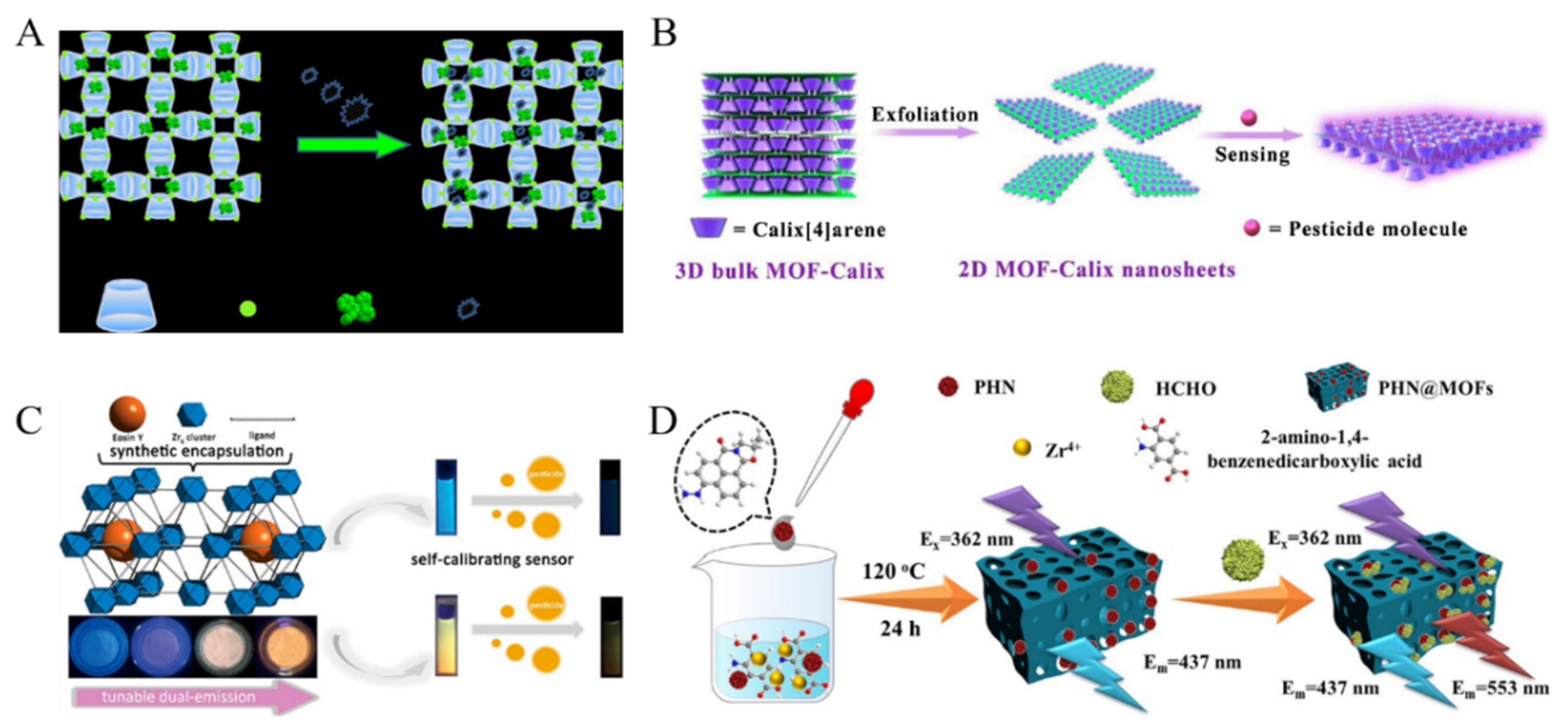

| MOFs | Targets | Linear Range | LOD | Ref. |
|---|---|---|---|---|
| NH2–Cu-MOF | TNP | 0.5~30 μM | 80 nM | [108] |
| RhB@Cd-MOFs | 4-nitroaniline | 0~0.054 mM | 43.06 μM | [113] |
| 2D MOF-Calix | glyphosate | 2.5~45 μM | 2.25 μM | [120] |
| EY-Zr-MOF | nitenpyram | 0~0.1 mM | 0.94 μM | [122] |
| PHN@UiO-66-NH2 | FA | 1~3 and 3~4 μM | 0.173 μM | [123] |
| UiO-67/Ce-PC | glyphosate | 0.02~30 μg/mL | 0.0062 μg/mL | [116] |
| Cd-MOFs | dinotefuran | 0~130 μM | 2.09 ppm | [119] |
| MB@Cd-MOF | carbaryl | 0~90 μM | 6.7 ng/mL | [121] |
| Zn-MOF | DOX, TET, OTC and CTC | 0.001~46.67 μM for DOX, 0.001~53.33 μM for TET, OTC and CTC | 0.56, 0.53, 0.58 and 0.86 nM | [124] |
| Zn-MOFs | ofloxacin | 0~0.0215 mM | 0.52 μM | [125] |
| Cd-MOFs | NFT and NFZ | 4~18 nM | 0.15 and 0.29 nM | [126] |
| Eu-MOFs | BRH and TET | 0.5~320 μM and 0.05~160 μM | 78 nM and 17 nM | [128] |
| Zn-MOFs | TEA, TET and NB | 5~35 μM, 1~7.5 μM and 2~15 μM | 1.07 μM, 0.1 μM and 0.2 μM | [129] |
| Zn-MOFs | OTC | 0.02~13 μM | 0.017 μM | [132] |
| Tb3+-modified Cd-MOFs | CFX | 0~6 μM | 26.7 nM | [133] |
| FSS@MOF-5/GMP-Eu | TET | 0~20 μM | 18.5 nM | [134] |
| ZIF-8@PCN-128Y | TET | 0.4~200 μM | 60 nM | [135] |
| Zn-BTEC MOFs | CTC | 0~8 μM | 28 nM | [136] |
| Yb-NH2-TPDC MOFs | gossypol | 25~100 μg/mL | 25 μg/mL | [137] |
| NH2-Cu-MOF | hypoxanthine | 10~2000 μM | 3.93 μM | [138] |
| Pyrene-modified Hf-UiO-66 | UA | 0~30 μM | 1.4 μM | [139] |
| Eu3+-modified Mn-MOFs | histidine | 0~30 μM | 0.23 μM | [140] |
| Eu/Bi-MOF | histidine | 0.001~10 mM | 0.18 μM | [141] |
| Zn-MOFs | 3-nitrotyrosine | 0~4 μM | 0.3099 μM | [142] |
| GNR and QD-embeded MOFs | BA | 0.002~5 ppm | 1.2 ppb | [143] |
| Tb-MOFs | DPA | 0.001~5 μM | 0.04 nM | [146] |
| CdS QDs@ZIF-8 | DPA | 0.1~150 μM | 67 nM | [147] |
| HQCA-modified UiO-66-NH2 | creatinine | 0.05~200 μM | 4.7 nM | [148] |
| RhB@Di-MOF | Fe3+ and AA | 1~10 μM and 1~25 μM | 0.36 μM and 0.31 μM | [149] |
| Eu(III)/Tb(III)@MOF-SO3− | tt-MA | 0~20 μg/mL | 0.1 μg/mL | [150] |
4. Biosensors
4.1. Small Biomolecules

4.2. Nucleic Acids
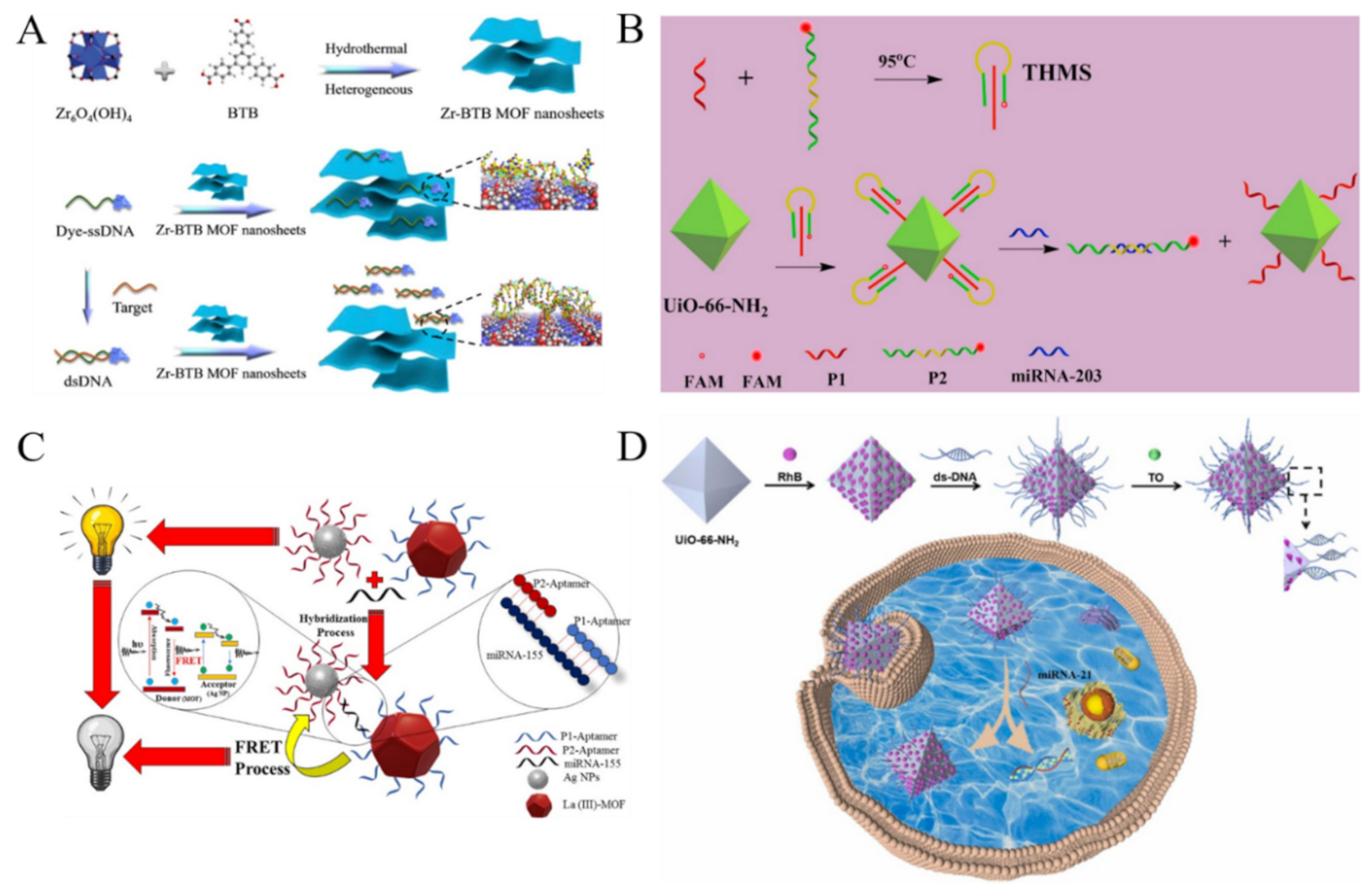
4.3. Enzymes

4.4. Proteins
4.5. Others
| Probes | Targets | Linear Range | LOD | Ref. |
|---|---|---|---|---|
| Tb-MOFs and aptamer-modified AuNPs | ATP | 0.5~10 μM | 0.32 μM | [161] |
| ZIF-67 and FAM-aptamer | ATP | 0.03~30 μM | 29 nM | [162] |
| Cr-MIL-101 and FAM-aptamer | ATP | 5~400 μM | 1.7 μM | [163] |
| Tb-MOFs, aptamer and AuNPs | ATP | 0.05~10 μM | 23 nM | [164] |
| CoxZn100-x-ZIF (x = 0–100) and FAM-aptamer | GTP | 0~50 μM | 0.13 μM | [165] |
| UiO-66-NH2 and TAMRA-aptamer | AFB1 | 0~180 ng/mL | 0.35 ng/mL | [166] |
| Cu/UiO-66 and ROX-aptamer | CAP | 0.2~10 nM | 0.09 nM | [167] |
| MOF−MoS2 and ROX/TAMRA-aptamer | CAP and 17E | 0~5 nM | 200 and 180 pM | [168] |
| Zr-MOFs and aptamer | OTA | 0.10~160 pg/mL | 0.051 pg/mL | [169] |
| Cu-MOFs and FAM-aptamer | H5N1 antibody | 0.005~1 μM | 1.6 nM | [198] |
| Cu-MOFs and FAM-aptamer | dsDNA | 4~200 nM | 1.3 nM | [172] |
| UiO-66-NH2 and FAM-DNA | miRNA | 1~160 nM | 400 pM | [175] |
| DNA-modified Ln-MOFs and DNA-modified AgNPs | miRNA-155 | 0.0027~0.01 pM | 5.2 fM | [179] |
| Tb-MOFs | ALP | 0~8 mU/mL | 0.002 mU/mL | [186] |
| RhB@MOF-5 | β-glucuronidase | 0.1~10 U/L | 0.03 U/L | [187] |
| Cu@Eu-BTC MOFs | ALP | 0.3~24 mU/mL | 0.02 mU/mL | [190] |
| Ln-MOFs | PPO | 0.001~0.1 mU/mL | 0.12 mU/mL | [192] |
| EpCAM-modified UiO-66-NH2 | exosomes | 168~1 × 106 particles/μL | 16.72 particles/μL | [199] |
| Zr-UiO-66-B(OH)2 | E. coli | 5~2.5 × 104 CFU/mL | 1 CFU/mL | [201] |
5. Conclusions
Author Contributions
Funding
Conflicts of Interest
References
- Mohan, B.; Kumar, S.; Kumar, V.; Jiao, T.; Sharma, H.K.; Chen, Q. Electrochemiluminescence metal-organic frameworks biosensing materials for detecting cancer biomarkers. TrAC Trends Anal. Chem. 2022, 157, 116735–116750. [Google Scholar] [CrossRef]
- Karmakar, A.; Li, J. Luminescent MOFs (lmofs): Recent advancement towards a greener wled technology. Chem. Commun. 2022, 58, 10768–10788. [Google Scholar] [CrossRef] [PubMed]
- Campbell, M.G.; Dinca, M. Metal-organic frameworks as active materials in electronic sensor devices. Sensors 2017, 17, 1108. [Google Scholar] [CrossRef] [PubMed]
- Liu, L.; Zhou, Y.; Liu, S.; Xu, M. The applications of metal−organic frameworks in electrochemical sensors. ChemElectroChem 2018, 5, 6–19. [Google Scholar] [CrossRef] [Green Version]
- He, T.; Kong, X.-J.; Li, J.-R. Chemically stable metal-organic frameworks: Rational construction and application expansion. Acc. Chem. Res. 2021, 54, 3083–3094. [Google Scholar] [CrossRef]
- Wang, J.; Li, N.; Xu, Y.; Pang, H. Two-dimensional MOF and cof nanosheets: Synthesis and applications in electrochemistry. Chem. Eur. J. 2020, 26, 6402–6422. [Google Scholar] [CrossRef]
- Ma, Y.J.; Jiang, X.X.; Lv, Y.K. Recent advances in preparation and applications of magnetic framework composites. Chem. Asian J. 2019, 14, 3515–3530. [Google Scholar] [CrossRef]
- Wang, S.; McGuirk, C.M.; d’Aquino, A.; Mason, J.A.; Mirkin, C.A. Metal-organic framework nanoparticles. Adv. Mater. 2018, 30, e1800202. [Google Scholar] [CrossRef]
- Liu, B.; Vellingiri, K.; Jo, S.-H.; Kumar, P.; Ok, Y.S.; Kim, K.-H. Recent advances in controlled modification of the size and morphology of metal-organic frameworks. Nano Res. 2018, 11, 4441–4467. [Google Scholar] [CrossRef]
- Tranchemontagne, D.J.; Mendoza-Cortes, J.L.; O’Keeffe, M.; Yaghi, O.M. Secondary building units, nets and bonding in the chemistry of metal-organic frameworks. Chem. Soc. Rev. 2009, 38, 1257–1283. [Google Scholar] [CrossRef]
- Yu, X.; Wang, L.; Cohen, S.M. Photocatalytic metal–organic frameworks for organic transformations. CrystEngComm 2017, 19, 4126–4136. [Google Scholar] [CrossRef]
- Kolobov, N.; Goesten, M.G.; Gascon, J. Metal-organic frameworks: Molecules or semiconductors in photocatalysis? Angew. Chem. Int. Ed. 2021, 60, 26038–26052. [Google Scholar] [CrossRef] [PubMed]
- Sohrabi, H.; Javanbakht, S.; Oroojalian, F.; Rouhani, F.; Shaabani, A.; Majidi, M.R.; Hashemzaei, M.; Hanifehpour, Y.; Mokhtarzadeh, A.; Morsali, A. Nanoscale metal-organic frameworks: Recent developments in synthesis, modifications and bioimaging applications. Chemosphere 2021, 281, 130717–130751. [Google Scholar] [CrossRef] [PubMed]
- Liu, Y.; Jiang, T.; Liu, Z. Metal-organic frameworks for bioimaging: Strategies and challenges. Nanotheranostics 2022, 6, 143–160. [Google Scholar] [CrossRef]
- Zhao, Y.; Zeng, H.; Zhu, X.W.; Lu, W.; Li, D. Metal-organic frameworks as photoluminescent biosensing platforms: Mechanisms and applications. Chem. Soc. Rev. 2021, 50, 4484–4513. [Google Scholar] [CrossRef]
- Karmakar, A.; Samanta, P.; Dutta, S.; Ghosh, S.K. Fluorescent “turn-on” sensing based on metal-organic frameworks (MOFs). Chem. Asian J. 2019, 14, 4506–4519. [Google Scholar] [CrossRef]
- Asad, M.; Imran Anwar, M.; Abbas, A.; Younas, A.; Hussain, S.; Gao, R.; Li, L.-K.; Shahid, M.; Khan, S. AIE based luminescent porous materials as cutting-edge tool for environmental monitoring: State of the art advances and perspectives. Coord. Chem. Rev. 2022, 463, 214539–214564. [Google Scholar] [CrossRef]
- Liu, K.; You, H.; Zheng, Y.; Jia, G.; Song, Y.; Huang, Y.; Yang, M.; Jia, J.; Guo, N.; Zhang, H. Facile and rapid fabrication of metal–organic framework nanobelts and color-tunable photoluminescence properties. J. Mater. Chem. 2010, 20, 3272–3279. [Google Scholar] [CrossRef]
- Liu, K.; You, H.; Jia, G.; Zheng, Y.; Song, Y.; Yang, M.; Huang, Y.; Zhang, H. Coordination-induced formation of one-dimensional nanostructures of europium benzene-1,3,5-tricarboxylate and its solid-state thermal transformation. Cryst. Growth Des. 2009, 9, 3519–3524. [Google Scholar] [CrossRef]
- Sun, M.; Zhang, L.; Xu, S.; Yu, B.; Wang, Y.; Zhang, L.; Zhang, W. Carbon dots-decorated hydroxyapatite nanowires-lanthanide metal-organic framework composites as fluorescent sensors for the detection of dopamine. Analyst 2022, 147, 947–955. [Google Scholar] [CrossRef]
- Xu, O.; Wan, S.; Yang, J.; Song, H.; Dong, L.; Xia, J.; Zhu, X. Ni-MOF functionalized carbon dots with fluorescence and adsorption performance for rapid detection of Fe (III) and ascorbic acid. J. Fluoresc. 2022, 32, 1743–1754. [Google Scholar] [CrossRef] [PubMed]
- Yan, F.; Wang, X.; Wang, Y.; Yi, C.; Xu, M.; Xu, J. Sensing performance and mechanism of carbon dots encapsulated into metal-organic frameworks. Microchim. Acta 2022, 189, 379–395. [Google Scholar] [CrossRef] [PubMed]
- Li, J.; Zhang, N.; Yang, X.; Yang, X.; Wang, Z.; Liu, H. Rhb@MOF-5 composite film as a fluorescence sensor for detection of chilled pork freshness. Biosensors 2022, 12, 544. [Google Scholar] [CrossRef] [PubMed]
- Chen, D.M.; Zhang, N.N.; Liu, C.S.; Du, M. Dual-emitting dye@MOF composite as a self-calibrating sensor for 2,4,6-trinitrophenol. ACS Appl. Mater. Interfaces 2017, 9, 24671–24677. [Google Scholar] [CrossRef] [PubMed]
- Jin, S.; Son, H.J.; Farha, O.K.; Wiederrecht, G.P.; Hupp, J.T. Energy transfer from quantum dots to metal-organic frameworks for enhanced light harvesting. J. Am. Chem. Soc. 2013, 135, 955–958. [Google Scholar] [CrossRef]
- Xu, L.; Pan, M.; Fang, G.; Wang, S. Carbon dots embedded metal-organic framework@molecularly imprinted nanoparticles for highly sensitive and selective detection of quercetin. Sens. Actuators B Chem. 2019, 286, 321–327. [Google Scholar] [CrossRef]
- Zhao, Y.; Li, D. Lanthanide-functionalized metal-organic frameworks as ratiometric luminescent sensors. J. Mater. Chem. C 2020, 8, 12739–12754. [Google Scholar] [CrossRef]
- Liu, Y.; Xie, X.-Y.; Cheng, C.; Shao, Z.-S.; Wang, H.-S. Strategies to fabricate metal-organic framework (MOF)-based luminescent sensing platforms. J. Mater. Chem. C 2019, 7, 10743–10763. [Google Scholar] [CrossRef]
- Dong, J.; Zhao, D.; Lu, Y.; Sun, W.-Y. Photoluminescent metal-organic frameworks and their application for sensing biomolecules. J. Mater. Chem. A 2019, 7, 22744–22767. [Google Scholar] [CrossRef]
- Li, J.; Yao, S.-L.; Liu, S.-J.; Chen, Y.-Q. Fluorescent sensors for aldehydes based on luminescent metal-organic frameworks. Dalton Trans. 2021, 50, 7166–7175. [Google Scholar] [CrossRef]
- Shi, L.; Li, N.; Wang, D.; Fan, M.; Zhang, S.; Gong, Z. Environmental pollution analysis based on the luminescent metal organic frameworks: A review. TrAC Trends Anal. Chem. 2021, 134, 116131–116150. [Google Scholar] [CrossRef]
- Kukkar, D.; Vellingiri, K.; Kim, K.-H.; Deep, A. Recent progress in biological and chemical sensing by luminescent metal-organic frameworks. Sens. Actuators B Chem. 2018, 273, 1346–1370. [Google Scholar] [CrossRef]
- Carrasco, S. Metal-organic frameworks for the development of biosensors: A current overview. Biosensors 2018, 8, 92. [Google Scholar] [CrossRef] [PubMed] [Green Version]
- Yan, B. Photofunctional MOF-based hybrid materials for the chemical sensing of biomarkers. J. Mater. Chem. C 2019, 7, 8155–8175. [Google Scholar] [CrossRef]
- Diamantis, S.A.; Margariti, A.; Pournara, A.D.; Papaefstathiou, G.S.; Manos, M.J.; Lazarides, T. Luminescent metal-organic frameworks as chemical sensors: Common pitfalls and proposed best practices. Inorg. Chem. Front. 2018, 5, 1493–1511. [Google Scholar] [CrossRef]
- Wu, F.; Ye, J.; Cao, Y.; Wang, Z.; Miao, T.; Shi, Q. Recent advances in fluorescence sensors based on DNA-MOF hybrids. Luminescence 2020, 35, 440–446. [Google Scholar] [CrossRef]
- Huo, Y.; Liu, S.; Gao, Z.; Ning, B.; Wang, Y. State-of-the-art progress of switch fluorescence biosensors based on metal-organic frameworks and nucleic acids. Microchim. Acta 2021, 188, 168–196. [Google Scholar] [CrossRef]
- Yu, Q.; Li, Z.; Cao, Q.; Qu, S.; Jia, Q. Advances in luminescent metal-organic framework sensors based on post-synthetic modification. TrAC Trends Anal. Chem. 2020, 129, 115939–115955. [Google Scholar] [CrossRef]
- Li, B.Z.; Suo, T.Y.; Xie, S.Y.; Xia, A.Q.; Ma, Y.J.; Huang, H.; Zhang, X.; Hu, Q. Rational design, synthesis, and applications of carbon dots@metal-organic frameworks (cd@MOF) based sensors. TrAC Trends Anal. Chem. 2021, 135, 116163–116174. [Google Scholar] [CrossRef]
- Wang, X.S.; Chrzanowski, M.; Wojtas, L.; Chen, Y.S.; Ma, S. Formation of a metalloporphyrin-based nanoreactor by postsynthetic metal-ion exchange of a polyhedral-cage containing a metal-metalloporphyrin framework. Chem. Eur. J. 2013, 19, 3297–3301. [Google Scholar] [CrossRef]
- Yang, L.-Z.; Wang, J.; Kirillov, A.M.; Dou, W.; Xu, C.; Fang, R.; Xu, C.-L.; Liu, W.-S. 2D lanthanide MOFs driven by a rigid 3,5-bis(3-carboxy-phenyl)pyridine building block: Solvothermal syntheses, structural features, and photoluminescence and sensing properties. CrystEngComm 2016, 18, 6425–6436. [Google Scholar] [CrossRef]
- Yan, B. Luminescence response mode and chemical sensing mechanism for lanthanide-functionalized metal-organic framework hybrids. Inorg. Chem. Front. 2021, 8, 201–233. [Google Scholar] [CrossRef]
- Goshisht, M.K.; Tripathi, N. Fluorescence-based sensors as an emerging tool for anion detection: Mechanism, sensory materials and applications. J. Mater. Chem. C 2021, 9, 9820–9850. [Google Scholar] [CrossRef]
- De Silva, A.P.; Gunaratne, H.Q.; Gunnlaugsson, T.; Huxley, A.J.; McCoy, C.P.; Rademacher, J.T.; Rice, T.E. Signaling recognition events with fluorescent sensors and switches. Chem. Rev. 1997, 97, 1515–1566. [Google Scholar] [CrossRef] [PubMed]
- Shakya, S.; Khan, I.M. Charge transfer complexes: Emerging and promising colorimetric real-time chemosensors for hazardous materials. J. Hazard. Mater. 2021, 403, 123537. [Google Scholar] [CrossRef] [PubMed]
- Zhang, J.; Zhou, R.; Tang, D.; Hou, X.; Wu, P. Optically-active nanocrystals for inner filter effect-based fluorescence sensing: Achieving better spectral overlap. TrAC Trends Anal. Chem. 2019, 110, 183–190. [Google Scholar] [CrossRef]
- Chen, L.; Liu, D.; Zheng, L.; Yi, S.; He, H. A structure-dependent ratiometric fluorescence sensor based on metal-organic framework for detection of 2,6-pyridinedicarboxylic acid. Anal. Bioanal. Chem. 2021, 413, 4227–4236. [Google Scholar] [CrossRef]
- Sousaraei, A.; Queiros, C.; Moscoso, F.G.; Lopes-Costa, T.; Pedrosa, J.M.; Silva, A.M.G.; Cunha-Silva, L.; Cabanillas-Gonzalez, J. Subppm amine detection via absorption and luminescence turn-on caused by ligand exchange in metal organic frameworks. Anal. Chem. 2019, 91, 15853–15859. [Google Scholar] [CrossRef]
- Cao, D.; Liu, Z.; Verwilst, P.; Koo, S.; Jangjili, P.; Kim, J.S.; Lin, W. Coumarin-based small-molecule fluorescent chemosensors. Chem. Rev. 2019, 119, 10403–10519. [Google Scholar] [CrossRef]
- Raymo, F.M.; Yildiz, I. Luminescent chemosensors based on semiconductor quantum dots. Phys. Chem. Chem. Phys. 2007, 9, 2036–2043. [Google Scholar] [CrossRef]
- Zheng, P.; Wu, N. Fluorescence and sensing applications of graphene oxide and graphene quantum dots: A review. Chem. Asian J. 2017, 12, 2343–2353. [Google Scholar] [CrossRef] [PubMed]
- Shellaiah, M.; Sun, K. Luminescent metal nanoclusters for potential chemosensor applications. Chemosensors 2017, 5, 36. [Google Scholar] [CrossRef] [Green Version]
- Chua, M.H.; Shah, K.W.; Zhou, H.; Xu, J. Recent advances in aggregation-induced emission chemosensors for anion sensing. Molecules 2019, 24, 2711. [Google Scholar] [CrossRef] [PubMed] [Green Version]
- Zhang, Y.; Yuan, S.; Day, G.; Wang, X.; Yang, X.; Zhou, H.-C. Luminescent sensors based on metal-organic frameworks. Coord. Chem. Rev. 2018, 354, 28–45. [Google Scholar] [CrossRef]
- Lakshmi, P.R.; Nanjan, P.; Kannan, S.; Shanmugaraju, S. Recent advances in luminescent metal-organic frameworks (lmofs) based fluorescent sensors for antibiotics. Coord. Chem. Rev. 2021, 435, 213793–213819. [Google Scholar] [CrossRef]
- Hao, Y.; Chen, S.; Zhou, Y.; Zhang, Y.; Xu, M. Recent progress in metal-organic framework (MOF) based luminescent chemodosimeters. Nanomaterials 2019, 9, 974. [Google Scholar] [CrossRef] [PubMed] [Green Version]
- Fang, X.; Zong, B.; Mao, S. Metal-organic framework-based sensors for environmental contaminant sensing. Nano-Micro Lett. 2018, 10, 64–82. [Google Scholar] [CrossRef] [PubMed] [Green Version]
- Kanan, S.M.; Malkawi, A. Recent advances in nanocomposite luminescent metal-organic framework sensors for detecting metal ions. Comments Inorg. Chem. 2021, 41, 1–66. [Google Scholar] [CrossRef]
- Shayegan, H.; Ali, G.A.M.; Safarifard, V. Recent progress in the removal of heavy metal ions from water using metal-organic frameworks. ChemistrySelect 2020, 5, 124–146. [Google Scholar] [CrossRef] [Green Version]
- Samanta, P.; Let, S.; Mandal, W.; Dutta, S.; Ghosh, S.K. Luminescent metal-organic frameworks (lmofs) as potential probes for the recognition of cationic water pollutants. Inorg. Chem. Front. 2020, 7, 1801–1821. [Google Scholar] [CrossRef]
- Razavi, S.A.A.; Morsali, A. Metal ion detection using luminescent-MOFs: Principles, strategies and roadmap. Coord. Chem. Rev. 2020, 415, 213299–213343. [Google Scholar] [CrossRef]
- Gomez, G.E.; Dos Santos Afonso, M.; Baldoni, H.A.; Roncaroli, F.; Soler-Illia, G. Luminescent lanthanide metal organic frameworks as chemosensing platforms towards agrochemicals and cations. Sensors 2019, 19, 1260. [Google Scholar] [CrossRef] [PubMed] [Green Version]
- Chen, J.; Chen, H.; Wang, T.; Li, J.; Wang, J.; Lu, X. Copper ion fluorescent probe based on Zr-MOFs composite material. Anal. Chem. 2019, 91, 4331–4336. [Google Scholar] [CrossRef] [PubMed]
- Cheng, C.; Zhang, R.; Wang, J.; Zhang, Y.; Wen, C.; Tan, Y.; Yang, M. An ultrasensitive and selective fluorescent nanosensor based on porphyrinic metal-organic framework nanoparticles for Cu2+ detection. Analyst 2020, 145, 797–804. [Google Scholar] [CrossRef] [PubMed]
- Chen, Y.-Z.; Jiang, H.-L. Porphyrinic metal–organic framework catalyzed heck-reaction: Fluorescence “turn-on” sensing of Cu(ii) ion. Chem. Mater. 2016, 28, 6698–6704. [Google Scholar] [CrossRef]
- Xia, Y.D.; Sun, Y.Q.; Cheng, Y.; Xia, Y.; Yin, X.B. Rational design of dual-ligand eu-MOF for ratiometric fluorescence sensing Cu2+ ions in human serum to diagnose wilson’s disease. Anal. Chim. Acta. 2022, 1204, 339731–339740. [Google Scholar] [CrossRef]
- Zhang, Q.; Zhang, X.; Shu, Y.; Wang, J. Metal-organic frameworks encapsulating carbon dots enable fast speciation of mono- and divalent copper. Anal. Chem. 2022, 94, 2255–2262. [Google Scholar] [CrossRef]
- Zhong, T.; Li, D.; Li, C.; Zhang, Z.; Wang, G. Turn-on fluorescent sensor based on curcumin@MOF-5 for the sensitive detection of Al3+. Anal. Methods 2022, 14, 2714–2722. [Google Scholar] [CrossRef]
- Li, Q.; Wu, X.; Huang, X.; Deng, Y.; Chen, N.; Jiang, D.; Zhao, L.; Lin, Z.; Zhao, Y. Tailoring the fluorescence of AIE-active metal-organic frameworks for aqueous sensing of metal ions. ACS Appl. Mater. Interfaces 2018, 10, 3801–3809. [Google Scholar] [CrossRef]
- Xu, H.; Gao, J.; Qian, X.; Wang, J.; He, H.; Cui, Y.; Yang, Y.; Wang, Z.; Qian, G. Metal–organic framework nanosheets for fast-response and highly sensitive luminescent sensing of Fe3+. J. Mater. Chem. A 2016, 4, 10900–10905. [Google Scholar] [CrossRef]
- Zhao, Y.; Zhai, X.; Shao, L.; Li, L.; Liu, Y.; Zhang, X.; Liu, J.; Meng, F.; Fu, Y. An ultra-high quantum yield Tb-MOF with phenolic hydroxyl as the recognition group for a highly selective and sensitive detection of Fe3+. J. Mater. Chem. C 2021, 9, 15840–15847. [Google Scholar] [CrossRef]
- Zhang, Z.; Wei, Z.; Meng, F.; Su, J.; Chen, D.; Guo, Z.; Xing, H. Rhb-embedded zirconium-naphthalene-based metal-organic framework composite as a luminescent self-calibrating platform for the selective detection of inorganic ions. Chem. Eur. J. 2020, 26, 1661–1667. [Google Scholar] [CrossRef] [PubMed]
- Puglisi, R.; Pellegrino, A.L.; Fiorenza, R.; Scire, S.; Malandrino, G. A facile one-pot approach to the synthesis of gd-eu based metal-organic frameworks and applications to sensing of Fe3+ and CR2O72− ions. Sensors 2021, 21, 1679. [Google Scholar] [CrossRef] [PubMed]
- Qi, C.; Xu, Y.-B.; Li, H.; Chen, X.-B.; Xu, L.; Liu, B. A highly sensitive and selective turn-off fluorescence sensor for Fe3+ detection based on a terbium metal-organic framework. J. Solid State Chem. 2021, 294, 121835–121841. [Google Scholar] [CrossRef]
- Yin, X.B.; Sun, Y.Q.; Yu, H.; Cheng, Y.; Wen, C. Design and multiple applications of mixed-ligand metal-organic frameworks with dual emission. Anal. Chem. 2022, 94, 4938–4947. [Google Scholar] [CrossRef]
- Dang, S.; Wang, T.; Yi, F.; Liu, Q.; Yang, W.; Sun, Z.M. A nanoscale multiresponsive luminescent sensor based on a terbium(III) metal-organic framework. Chem. Asian. J. 2015, 10, 1703–1709. [Google Scholar] [CrossRef]
- Shin, W.-J.; Jung, M.; Ryu, J.-S.; Hwang, J.; Lee, K.-S. Revisited digestion methods for trace element analysis in human hair. J. Anal. Sci. Technol. 2020, 11, 1. [Google Scholar] [CrossRef]
- Hao Guo, N.W.; Peng, L.; Chen, Y.; Liu, Y.; Li, C.; Zhang, H.; Yang, W. A novel ratiometric fluorescence sensor based on lanthanide-functionalized MOF for Hg2+ detection. Talanta 2022, 250, 123710–123717. [Google Scholar] [CrossRef]
- Wang, H.; Wang, X.; Liang, M.; Chen, G.; Kong, R.M.; Xia, L.; Qu, F. A boric acid-functionalized lanthanide metal-organic framework as a fluorescence “turn-on” probe for selective monitoring of Hg2+ and CH3Hg+. Anal. Chem. 2020, 92, 3366–3372. [Google Scholar] [CrossRef]
- Li, H.; Li, D.; Qin, B.; Li, W.; Zheng, H.; Zhang, X.; Zhang, J. Turn-on fluorescence in a stable Cd(ii) metal-organic framework for highly sensitive detection of Cr3+ in water. Dye. Pigment. 2020, 178, 108359–108364. [Google Scholar] [CrossRef]
- Liu, J.; Wang, X.; Zhao, Y.; Xu, Y.; Pan, Y.; Feng, S.; Liu, J.; Huang, X.; Wang, H. Nh3 plasma functionalization of UiO-66-NH2 for highly enhanced selective fluorescence detection of u(vi) in water. Anal. Chem. 2022, 94, 10091–10100. [Google Scholar] [CrossRef] [PubMed]
- Steinegger, A.; Wolfbeis, O.S.; Borisov, S.M. Optical sensing and imaging of pH values: Spectroscopies, materials, and applications. Chem. Rev. 2020, 120, 12357–12489. [Google Scholar] [CrossRef] [PubMed]
- Jiang, H.L.; Feng, D.; Wang, K.; Gu, Z.Y.; Wei, Z.; Chen, Y.P.; Zhou, H.C. An exceptionally stable, porphyrinic Zr metal-organic framework exhibiting pH-dependent fluorescence. J. Am. Chem. Soc. 2013, 135, 13934–13938. [Google Scholar] [CrossRef]
- Qiao, J.; Liu, X.; Zhang, L.; Eubank, J.F.; Liu, X.; Liu, Y. Unique fluorescence turn-on and turn-off-on responses to acids by a carbazole-based metal-organic framework and theoretical studies. J. Am. Chem. Soc. 2022, 144, 17054–17063. [Google Scholar] [CrossRef] [PubMed]
- Chen, F.G.; Xu, W.; Chen, J.; Xiao, H.P.; Wang, H.Y.; Chen, Z.; Ge, J.Y. Dysprosium(III) metal-organic framework demonstrating ratiometric luminescent detection of pH, magnetism, and proton conduction. Inorg. Chem. 2022, 61, 5388–5396. [Google Scholar] [CrossRef]
- Harbuzaru, B.V.; Corma, A.; Rey, F.; Jorda, J.L.; Ananias, D.; Carlos, L.D.; Rocha, J. A miniaturized linear pH sensor based on a highly photoluminescent self-assembled europium(III) metal-organic framework. Angew. Chem. Int. Ed. 2009, 48, 6476–6479. [Google Scholar] [CrossRef]
- Wang, J.; Li, D.; Ye, Y.; Qiu, Y.; Liu, J.; Huang, L.; Liang, B.; Chen, B. A fluorescent metal-organic framework for food real-time visual monitoring. Adv. Mater. 2021, 33, 2008020–2008027. [Google Scholar] [CrossRef]
- Chen, H.; Wang, J.; Shan, D.; Chen, J.; Zhang, S.; Lu, X. Dual-emitting fluorescent metal-organic framework nanocomposites as a broad-range pH sensor for fluorescence imaging. Anal. Chem. 2018, 90, 7056–7063. [Google Scholar] [CrossRef]
- Jin, J.; Xue, J.; Liu, Y.; Yang, G.; Wang, Y.-Y. Recent progresses in luminescent metal-organic frameworks (lmofs) as sensors for the detection of anions and cations in aqueous solution. Dalton Trans. 2021, 50, 1950–1972. [Google Scholar] [CrossRef]
- Yi, F.-Y.; Chen, D.; Wu, M.-K.; Han, L.; Jiang, H.-L. Chemical sensors based on metal-organic frameworks. Chempluschem 2016, 81, 675–690. [Google Scholar] [CrossRef]
- Li, Y.; Li, J.-J.; Zhang, Q.; Zhang, J.-Y.; Zhang, N.; Fang, Y.-Z.; Yan, J.; Ke, Q. The multifunctional bodipy@eu-MOF nanosheets as bioimaging platform: A ratiometric fluorescencent sensor for highly efficient detection of F−, H2O2 and glucose. Sens. Actuators B Chem. 2022, 354, 131140–131153. [Google Scholar] [CrossRef]
- Zeng, X.; Hu, J.; Zhang, M.; Wang, F.; Wu, L.; Hou, X. Visual detection of fluoride anions using mixed lanthanide metal-organic frameworks with a smartphone. Anal. Chem. 2020, 92, 2097–2102. [Google Scholar] [CrossRef] [PubMed]
- Che, H.; Li, Y.; Zhang, S.; Chen, W.; Tian, X.; Yang, C.; Lu, L.; Zhou, Z.; Nie, Y. A portable logic detector based on eu-MOF for multi-target, on-site, visual detection of eu3+ and fluoride in groundwater. Sens. Actuators B Chem. 2020, 324, 128641–128650. [Google Scholar] [CrossRef]
- Dalapati, R.; Biswas, S. Post-synthetic modification of a metal-organic framework with fluorescent-tag for dual naked-eye sensing in aqueous medium. Sens. Actuators B Chem. 2017, 239, 759–767. [Google Scholar] [CrossRef]
- Sun, Y.Q.; Cheng, Y.; Yin, X.B. Dual-ligand lanthanide metal-organic framework for sensitive ratiometric fluorescence detection of hypochlorous acid. Anal. Chem. 2021, 93, 3559–3566. [Google Scholar] [CrossRef]
- Tan, H.; Wu, X.; Weng, Y.; Lu, Y.; Huang, Z.Z. Self-assembled FRET nanoprobe with metal-organic framework as a scaffold for ratiometric detection of hypochlorous acid. Anal. Chem. 2020, 92, 3447–3454. [Google Scholar] [CrossRef]
- Wang, X.Y.; Yin, H.Q.; Yin, X.B. MOF@cofs with strong multiemission for differentiation and ratiometric fluorescence detection. ACS Appl. Mater. Interfaces 2020, 12, 20973–20981. [Google Scholar] [CrossRef]
- Wang, Y.M.; Yang, Z.R.; Xiao, L.; Yin, X.B. Lab-on-MOFs: Color-coded multitarget fluorescence detection with white-light emitting metal-organic frameworks under single wavelength excitation. Anal. Chem. 2018, 90, 5758–5763. [Google Scholar] [CrossRef]
- Fan, C.; Lv, X.; Tian, M.; Yu, Q.; Mao, Y.; Qiu, W.; Wang, H.; Liu, G. A terbium(III)-functionalized zinc(ii)-organic framework for fluorometric determination of phosphate. Microchim. Acta 2020, 187, 84–90. [Google Scholar] [CrossRef]
- Shi, W.; Zhang, S.; Wang, Y.; Xue, Y.D.; Chen, M. Preparation of dual-ligands eu-MOF nanorods with dual fluorescence emissions for highly sensitive and selective ratiometric/visual fluorescence sensing phosphate. Sens. Actuators B Chem. 2022, 367, 132008–132015. [Google Scholar] [CrossRef]
- Zhang, X.; Ma, Q.; Liu, X.; Niu, H.; Luo, L.; Li, R.; Feng, X. A turn-off eu-MOF@Fe2+ sensor for the selective and sensitive fluorescence detection of bromate in wheat flour. Food Chem. 2022, 382, 132379–132386. [Google Scholar] [CrossRef] [PubMed]
- Karmakar, A.; Kumar, N.; Samanta, P.; Desai, A.V.; Ghosh, S.K. A post-synthetically modified MOF for selective and sensitive aqueous-phase detection of highly toxic cyanide ions. Chem. Eur. J. 2016, 22, 864–868. [Google Scholar] [CrossRef] [PubMed]
- Jain, S.; Nehra, M.; Dilbaghi, N.; Kumar, R.; Kumar, S. Boric-acid-functionalized luminescent sensor for detection of chromate ions in aqueous solution. Mater. Lett. 2022, 306, 130933–130936. [Google Scholar] [CrossRef]
- Zhang, Y.; Liu, Y.; Huo, F.; Zhang, B.; Su, W.; Yang, X. Photoluminescence quenching in recyclable water-soluble Zn-based metal–organic framework nanoflakes for dichromate sensing. ACS Appl. Nano Mater. 2022, 5, 9223–9229. [Google Scholar] [CrossRef]
- Ma, Y.; Su, H.; Kuang, X.; Li, X.; Zhang, T.; Tang, B. Heterogeneous nano metal-organic framework fluorescence probe for highly selective and sensitive detection of hydrogen sulfide in living cells. Anal. Chem. 2014, 86, 11459–11463. [Google Scholar] [CrossRef]
- Gao, X.; Sun, G.; Wang, X.; Lin, X.; Wang, S.; Liu, Y. Rhb/UiO-66-n3 MOF-based ratiometric fluorescent detection and intracellular imaging of hydrogen sulfide. Sens. Actuators B Chem. 2021, 331, 129448–129457. [Google Scholar] [CrossRef]
- Rasheed, T.; Nabeel, F. Luminescent metal-organic frameworks as potential sensory materials for various environmental toxic agents. Coord. Chem. Rev. 2019, 401, 213065–213086. [Google Scholar] [CrossRef]
- Chen, J.; Zhang, Q.; Dong, J.; Xu, F.; Li, S. Amino-functionalized Cu metal-organic framework nanosheets as fluorescent probes for detecting tnp. Anal. Methods 2021, 13, 5328–5334. [Google Scholar] [CrossRef]
- Firuzabadi, F.D.; Alavi, M.A.; Zarekarizi, F.; Tehrani, A.A.; Morsali, A. A pillared metal-organic framework with rich π-electron linkers as a novel fluorescence probe for the highly selective and sensitive detection of nitroaromatics. Colloids Surf. A 2021, 622, 126631–126637. [Google Scholar] [CrossRef]
- Gu, P.; Wu, H.; Jing, T.; Li, Y.; Wang, Z.; Ye, S.; Lai, W.; Ferbinteanu, M.; Wang, S.; Huang, W. (4,5,8)-connected cationic coordination polymer material as explosive chemosensor based on the in situ generated AIE tetrazolyl-tetraphenylethylene derivative. Inorg. Chem. 2021, 60, 13359–13365. [Google Scholar] [CrossRef]
- Zhang, S.R.; Du, D.Y.; Qin, J.S.; Bao, S.J.; Li, S.L.; He, W.W.; Lan, Y.Q.; Shen, P.; Su, Z.M. A fluorescent sensor for highly selective detection of nitroaromatic explosives based on a 2D, extremely stable, metal-organic framework. Chem. Eur. J. 2014, 20, 3589–3594. [Google Scholar] [CrossRef] [PubMed]
- Wang, C.; Tian, L.; Zhu, W.; Wang, S.; Wang, P.; Liang, Y.; Zhang, W.; Zhao, H.; Li, G. Dye@bio-MOF-1 composite as a dual-emitting platform for enhanced detection of a wide range of explosive molecules. ACS Appl. Mater. Interfaces 2017, 9, 20076–20085. [Google Scholar] [CrossRef] [PubMed]
- Sun, Z.; Li, J.; Wang, X.; Zhao, Z.; Lv, R.; Zhang, Q.; Wang, F.; Zhao, Y. Rhb-encapsulated MOF-based composite as self-calibrating sensor for selective detection of 4-nitroaniline. J. Lumin. 2022, 241, 118480–118487. [Google Scholar] [CrossRef]
- Sharma, A.; Kim, D.; Park, J.-H.; Rakshit, S.; Seong, J.; Jeong, G.H.; Kwon, O.-H.; Lah, M.S. Mechanistic insight into the sensing of nitroaromatic compounds by metal-organic frameworks. Commun. Chem. 2019, 2, 39–46. [Google Scholar] [CrossRef] [Green Version]
- Qiu, Z.J.; Fan, S.T.; Xing, C.Y.; Song, M.M.; Nie, Z.J.; Xu, L.; Zhang, S.X.; Wang, L.; Zhang, S.; Li, B.J. Facile fabrication of an AIE-active metal-organic framework for sensitive detection of explosives in liquid and solid phases. ACS Appl. Mater. Interfaces 2020, 12, 55299–55307. [Google Scholar] [CrossRef]
- Qiang, Y.; Yang, W.; Zhang, X.; Luo, X.; Tang, W.; Yue, T.; Li, Z. UiO-67 decorated on porous carbon derived from ce-MOF for the enrichment and fluorescence determination of glyphosate. Microchim. Acta 2022, 189, 130–140. [Google Scholar] [CrossRef]
- Zhao, D.; Yu, S.; Jiang, W.-J.; Cai, Z.-H.; Li, D.-L.; Liu, Y.-L.; Chen, Z.-Z. Recent progress in metal-organic framework based fluorescent sensors for hazardous materials detection. Molecules 2022, 27, 2226. [Google Scholar] [CrossRef]
- Mukherjee, S.; Dutta, S.; More, Y.D.; Fajal, S.; Ghosh, S.K. Post-synthetically modified metal-organic frameworks for sensing and capture of water pollutants. Dalton Trans. 2021, 50, 17832–17851. [Google Scholar] [CrossRef]
- Jiao, Z.H.; Hou, S.L.; Kang, X.M.; Yang, X.P.; Zhao, B. Recyclable luminescence sensor for dinotefuran in water by stable cadmium-organic framework. Anal. Chem. 2021, 93, 6599–6603. [Google Scholar] [CrossRef]
- Yu, C.-X.; Hu, F.-L.; Song, J.-G.; Zhang, J.-L.; Liu, S.-S.; Wang, B.-X.; Meng, H.; Liu, L.-L.; Ma, L.-F. Ultrathin two-dimensional metal-organic framework nanosheets decorated with tetra-pyridyl calix[4]arene: Design, synthesis and application in pesticide detection. Sens. Actuators B Chem. 2020, 310, 127819–127825. [Google Scholar] [CrossRef]
- Zhang, Y.; Gao, L.; Ma, S.; Hu, T. Porous MB@Cd-MOF obtained by post-modification: Self-calibrated fluorescent turn-on sensor for highly sensitive detection of carbaryl. Cryst. Growth Des. 2022, 22, 2662–2669. [Google Scholar] [CrossRef]
- Wei, Z.; Chen, D.; Guo, Z.; Jia, P.; Xing, H. Eosin y-embedded zirconium-based metal-organic framework as a dual-emitting built-in self-calibrating platform for pesticide detection. Inorg. Chem. 2020, 59, 5386–5393. [Google Scholar] [CrossRef] [PubMed]
- Wang, X.; Rehman, A.; Kong, R.M.; Cheng, Y.; Tian, X.; Liang, M.; Zhang, L.; Xia, L.; Qu, F. Naphthalimide derivative-functionalized metal-organic framework for highly sensitive and selective determination of aldehyde by space confinement-induced sensitivity enhancement effect. Anal. Chem. 2021, 93, 8219–8227. [Google Scholar] [CrossRef] [PubMed]
- Li, C.; Yang, W.; Zhang, X.; Han, Y.; Tang, W.; Yue, T.; Li, Z. A 3D hierarchical dual-metal–organic framework heterostructure up-regulating the pre-concentration effect for ultrasensitive fluorescence detection of tetracycline antibiotics. J. Mater. Chem. C 2020, 8, 2054–2064. [Google Scholar] [CrossRef]
- Li, C.P.; Long, W.W.; Lei, Z.; Guo, L.; Xie, M.J.; Lu, J.; Zhu, X.D. Anionic metal-organic framework as a unique turn-on fluorescent chemical sensor for ultra-sensitive detection of antibiotics. Chem. Commun. 2020, 56, 12403–12406. [Google Scholar] [CrossRef]
- Liang, Y.; Li, J.; Yang, S.; Wu, S.; Zhu, M.; Fedin, V.P.; Zhang, Y.; Gao, E. Self-calibrated FRET fluorescent probe with metal-organic framework for proportional detection of nitrofuran antibiotics. Polyhedron 2022, 226, 116080–116087. [Google Scholar] [CrossRef]
- Yue, X.; Zhou, Z.; Li, M.; Jie, M.; Xu, B.; Bai, Y. Inner-filter effect induced fluorescent sensor based on fusiform Al-MOF nanosheets for sensitive and visual detection of nitrofuran in milk. Food Chem. 2022, 367, 130763– 130770. [Google Scholar] [CrossRef]
- Xiong, J.; Yang, L.; Gao, L.X.; Zhu, P.P.; Chen, Q.; Tan, K.J. A highly fluorescent lanthanide metal-organic framework as dual-mode visual sensor for berberine hydrochloride and tetracycline. Anal. Bioanal. Chem. 2019, 411, 5963–5973. [Google Scholar] [CrossRef]
- Wang, L.-B.; Wang, J.-J.; Yue, E.-L.; Li, J.-F.; Tang, L.; Wang, X.; Hou, X.-Y.; Zhang, Y.; Ren, Y.-X.; Chen, X.-L. Luminescent Zn (ii) coordination polymers for highly selective detection of triethylamine, nitrobenzene and tetracycline in water systems. Dye. Pigment. 2022, 197, 109863–109871. [Google Scholar] [CrossRef]
- Liu, X.; Zhang, X.; Li, R.; Du, L.; Feng, X.; Ding, Y. A highly sensitive and selective “turn off-on” fluorescent sensor based on sm-MOF for the detection of tertiary butylhydroquinone. Dye. Pigment. 2020, 178, 108347–108354. [Google Scholar] [CrossRef]
- Guo, G.; Wang, T.; Ding, X.; Wang, H.; Wu, Q.; Zhang, Z.; Ding, S.; Li, S.; Li, J. Fluorescent lanthanide metal-organic framework for rapid and ultrasensitive detection of methcathinone in human urine. Talanta 2022, 249, 123663–123670. [Google Scholar] [CrossRef] [PubMed]
- Chen, J.; Xu, F.; Zhang, Q.; Li, S.; Lu, X. Tetracycline antibiotics and NH4+ detection by Zn-organic framework fluorescent probe. Analyst 2021, 146, 6883–6892. [Google Scholar] [CrossRef] [PubMed]
- Qin, G.; Wang, J.; Li, L.; Yuan, F.; Zha, Q.; Bai, W.; Ni, Y. Highly water-stable Cd-MOF/Tb3+ ultrathin fluorescence nanosheets for ultrasensitive and selective detection of cefixime. Talanta 2021, 221, 121421–121428. [Google Scholar] [CrossRef] [PubMed]
- Gan, Z.; Zhang, W.; Shi, J.; Xu, X.; Hu, X.; Zhang, X.; Wang, X.; Arslan, M.; Xiao, J.; Zou, X. Collaborative compounding of metal-organic frameworks and lanthanide coordination polymers for ratiometric visual detection of tetracycline. Dye. Pigment. 2021, 194, 109545–109554. [Google Scholar] [CrossRef]
- Wang, X.; Zhang, L.; Ye, N.; Xiang, Y. Synthesis of a dual metal–organic framework heterostructure as a fluorescence sensing platform for rapid and sensitive detection of tetracycline in milk and beef samples. Food Anal. Methods 2022, 15, 2801–2809. [Google Scholar] [CrossRef]
- Yu, L.; Chen, H.; Yue, J.; Chen, X.; Sun, M.; Tan, H.; Asiri, A.M.; Alamry, K.A.; Wang, X.; Wang, S. Metal-organic framework enhances aggregation-induced fluorescence of chlortetracycline and the application for detection. Anal. Chem. 2019, 91, 5913–5921. [Google Scholar] [CrossRef] [PubMed]
- Luo, T.Y.; Das, P.; White, D.L.; Liu, C.; Star, A.; Rosi, N.L. Luminescence “turn-on” detection of gossypol using Ln3+-based metal-organic frameworks and Ln3+ salts. J. Am. Chem. Soc. 2020, 142, 2897–2904. [Google Scholar] [CrossRef]
- Hu, S.; Yan, J.; Huang, X.; Guo, L.; Lin, Z.; Luo, F.; Qiu, B.; Wong, K.-Y.; Chen, G. A sensing platform for hypoxanthine detection based on amino-functionalized metal organic framework nanosheet with peroxidase mimic and fluorescence properties. Sens. Actuators B Chem. 2018, 267, 312–319. [Google Scholar] [CrossRef]
- Dalapati, R.; Biswas, S. A pyrene-functionalized metal-organic framework for nonenzymatic and ratiometric detection of uric acid in biological fluid via conformational change. Inorg. Chem. 2019, 58, 5654–5663. [Google Scholar] [CrossRef]
- Xiao, J.; Song, L.; Liu, M.; Wang, X.; Liu, Z. Intriguing pH-modulated luminescence chameleon system based on postsynthetic modified dual-emitting Eu3+@Mn-MOF and its application for histidine chemosensor. Inorg. Chem. 2020, 59, 6390–6397. [Google Scholar] [CrossRef]
- Song, L.; Xiao, J.; Cui, R.; Wang, X.; Tian, F.; Liu, Z. Eu3+ doped bismuth metal-organic frameworks with ultrahigh fluorescence quantum yield and act as ratiometric turn-on sensor for histidine detection. Sens. Actuators B Chem. 2021, 336, 129753–129760. [Google Scholar] [CrossRef]
- Geng, J.; Li, Y.; Lin, H.; Liu, Q.; Lu, J.; Wang, X. A new three-dimensional zinc(ii) metal-organic framework as a fluorescence sensor for sensing the biomarker 3-nitrotyrosine. Dalton Trans. 2022, 51, 11390–11396. [Google Scholar] [CrossRef] [PubMed]
- Xia, Z.; Li, D.; Deng, W. Identification and detection of volatile aldehydes as lung cancer biomarkers by vapor generation combined with paper-based thin-film microextraction. Anal. Chem. 2021, 93, 4924–4931. [Google Scholar] [CrossRef] [PubMed]
- Zhang, S.Y.; Shi, W.; Cheng, P.; Zaworotko, M.J. A mixed-crystal lanthanide zeolite-like metal-organic framework as a fluorescent indicator for lysophosphatidic acid, a cancer biomarker. J. Am. Chem. Soc. 2015, 137, 12203–12206. [Google Scholar] [CrossRef] [PubMed]
- Wang, N.; Xie, M.; Wang, M.; Li, Z.; Su, X. UiO-66-NH2 MOF-based ratiometric fluorescent probe for the detection of dopamine and reduced glutathione. Talanta 2020, 220, 121352–121358. [Google Scholar] [CrossRef] [PubMed]
- Bhardwaj, N.; Bhardwaj, S.; Mehta, J.; Kim, K.H.; Deep, A. Highly sensitive detection of dipicolinic acid with a water-dispersible terbium-metal organic framework. Biosens. Bioelectron. 2016, 86, 799–804. [Google Scholar] [CrossRef]
- Li, X.; Luo, J.; Deng, L.; Ma, F.; Yang, M. In situ incorporation of fluorophores in zeolitic imidazolate framework-8 (ZIF-8) for ratio-dependent detecting a biomarker of anthrax spores. Anal. Chem. 2020, 92, 7114–7122. [Google Scholar] [CrossRef] [PubMed]
- Qu, S.; Cao, Q.; Ma, J.; Jia, Q. A turn-on fluorescence sensor for creatinine based on the quinoline-modified metal organic frameworks. Talanta 2020, 219, 121280–121286. [Google Scholar] [CrossRef]
- Guo, L.; Liu, Y.; Kong, R.; Chen, G.; Liu, Z.; Qu, F.; Xia, L.; Tan, W. A metal-organic framework as selectivity regulator for Fe3+ and ascorbic acid detection. Anal. Chem. 2019, 91, 12453–12460. [Google Scholar] [CrossRef]
- Qu, X.L.; Yan, B. Ln(III)-functionalized metal-organic frameworks hybrid system: Luminescence properties and sensor for trans, trans-muconic acid as a biomarker of benzene. Inorg. Chem. 2018, 57, 7815–7824. [Google Scholar] [CrossRef]
- Yin, H.Q.; Yang, J.C.; Yin, X.B. Ratiometric fluorescence sensing and real-time detection of water in organic solvents with one-pot synthesis of Ru@MIL-101(Al)-NH2. Anal. Chem. 2017, 89, 13434–13440. [Google Scholar] [CrossRef] [PubMed]
- Zhou, Y.; Zhang, D.; Xing, W.; Cuan, J.; Hu, Y.; Cao, Y.; Gan, N. Ratiometric and turn-on luminescence detection of water in organic solvents using a responsive europium-organic framework. Anal. Chem. 2019, 91, 4845–4851. [Google Scholar] [CrossRef] [PubMed]
- Yu, L.; Zheng, Q.; Wang, H.; Liu, C.; Huang, X.; Xiao, Y. Double-color lanthanide metal-organic framework based logic device and visual ratiometric fluorescence water microsensor for solid pharmaceuticals. Anal. Chem. 2020, 92, 1402–1408. [Google Scholar] [CrossRef] [PubMed]
- Chen, D.-M.; Sun, C.-X.; Peng, Y.; Zhang, N.-N.; Si, H.-H.; Liu, C.-S.; Du, M. Ratiometric fluorescence sensing and colorimetric decoding methanol by a bimetallic lanthanide-organic framework. Sens. Actuators B Chem. 2018, 265, 104–109. [Google Scholar] [CrossRef]
- Pashazadeh-Panahi, P.; Belali, S.; Sohrabi, H.; Oroojalian, F.; Hashemzaei, M.; Mokhtarzadeh, A.; de la Guardia, M. Metal-organic frameworks conjugated with biomolecules as efficient platforms for development of biosensors. TrAC Trends Anal. Chem. 2021, 141, 116285–116304. [Google Scholar] [CrossRef]
- Zhang, Q.; Wang, C.-F.; Lv, Y.-K. Luminescent switch sensors for the detection of biomolecules based on metal-organic frameworks. Analyst 2018, 143, 4221–4229. [Google Scholar] [CrossRef]
- Wang, H.S.; Wang, Y.H.; Ding, Y. Development of biological metal-organic frameworks designed for biomedical applications: From bio-sensing/bio-imaging to disease treatment. Nanoscale Adv. 2020, 2, 3788–3797. [Google Scholar] [CrossRef]
- Lin, Y.; Huang, Y.; Chen, X. Recent advances in metal-organic frameworks for biomacromolecule sensing. Chemosensors 2022, 10, 412. [Google Scholar] [CrossRef]
- Udourioh, G.A.; Solomon, M.M.; Epelle, E.I. Metal organic frameworks as biosensing materials for COVID-19. Cell. Mol. Bioeng. 2021, 14, 535–553. [Google Scholar] [CrossRef]
- Hu, P.P.; Liu, N.; Wu, K.Y.; Zhai, L.Y.; Xie, B.P.; Sun, B.; Duan, W.J.; Zhang, W.H.; Chen, J.X. Successive and specific detection of Hg2+ and I− by a DNA@MOF biosensor: Experimental and simulation studies. Inorg. Chem. 2018, 57, 8382–8389. [Google Scholar] [CrossRef]
- Sun, C.; Zhao, S.; Qu, F.; Han, W.; You, J. Determination of adenosine triphosphate based on the use of fluorescent terbium(III) organic frameworks and aptamer modified gold nanoparticles. Microchim. Acta 2019, 187, 34–42. [Google Scholar] [CrossRef] [PubMed]
- Wang, Z.; Zhou, X.; Li, Y.; Huang, Z.; Han, J.; Xie, G.; Liu, J. Sensing ATP: Zeolitic imidazolate framework-67 is superior to aptamers for target recognition. Anal. Chem. 2021, 93, 7707–7713. [Google Scholar] [CrossRef] [PubMed]
- Yao, J.; Yue, T.; Huang, C.; Wang, H. A magnified aptamer fluorescence sensor based on the metal organic frameworks adsorbed DNA with enzyme catalysis amplification for ultra-sensitive determination of ATP and its logic gate operation. Bioorganic Chem. 2021, 114, 105020–105027. [Google Scholar] [CrossRef] [PubMed]
- Qu, F.; Sun, C.; Lv, X.; You, J. A terbium-based metal-organic framework@gold nanoparticle system as a fluorometric probe for aptamer based determination of adenosine triphosphate. Microchim. Acta 2018, 185, 359–365. [Google Scholar] [CrossRef]
- Wang, Z.; Zhou, X.; Han, J.; Xie, G.; Liu, J. DNA coated cozn-ZIF metal-organic frameworks for fluorescent sensing guanosine triphosphate and discrimination of nucleoside triphosphates. Anal. Chim. Acta. 2022, 1207, 339806–339813. [Google Scholar] [CrossRef]
- Jia, Y.; Zhou, G.; Wang, X.; Zhang, Y.; Li, Z.; Liu, P.; Yu, B.; Zhang, J. A metal-organic framework/aptamer system as a fluorescent biosensor for determination of aflatoxin b1 in food samples. Talanta 2020, 219, 121342–121349. [Google Scholar] [CrossRef]
- Lu, Z.; Jiang, Y.; Wang, P.; Xiong, W.; Qi, B.; Zhang, Y.; Xiang, D.; Zhai, K. Bimetallic organic framework-based aptamer sensors: A new platform for fluorescence detection of chloramphenicol. Anal. Bioanal. Chem. 2020, 412, 5273–5281. [Google Scholar] [CrossRef]
- Amalraj, A.; Perumal, P. Dual-mode amplified fluorescence oligosensor mediated MOF-MoS2 for ultra-sensitive simultaneous detection of 17β -estradiol and chloramphenicol through catalytic target- recycling activity of exonuclease i. Microchem. J. 2022, 173, 106971–106980. [Google Scholar] [CrossRef]
- Li, W.; Zhang, X.; Hu, X.; Shi, Y.; Liang, N.; Huang, X.; Wang, X.; Shen, T.; Zou, X.; Shi, J. Simple design concept for dual-channel detection of ochratoxin a based on bifunctional metal-organic framework. ACS Appl. Mater. Interfaces 2022, 14, 5615–5623. [Google Scholar] [CrossRef]
- Wang, H.S.; Liu, H.L.; Wang, K.; Ding, Y.; Xu, J.J.; Xia, X.H.; Chen, H.Y. Insight into the unique fluorescence quenching property of metal-organic frameworks upon DNA binding. Anal. Chem. 2017, 89, 11366–11371. [Google Scholar] [CrossRef]
- Wang, X.Z.; Du, J.; Xiao, N.N.; Zhang, Y.; Fei, L.; LaCoste, J.D.; Huang, Z.; Wang, Q.; Wang, X.R.; Ding, B. Driving force to detect alzheimer’s disease biomarkers: Application of a thioflavine t@er-MOF ratiometric fluorescent sensor for smart detection of presenilin 1, amyloid beta-protein and acetylcholine. Analyst 2020, 145, 4646–4663. [Google Scholar] [CrossRef]
- Chen, L.; Zheng, H.; Zhu, X.; Lin, Z.; Guo, L.; Qiu, B.; Chen, G.; Chen, Z.N. Metal-organic frameworks-based biosensor for sequence-specific recognition of double-stranded DNA. Analyst 2013, 138, 3490–3493. [Google Scholar] [CrossRef] [PubMed]
- Zhao, M.; Wang, Y.; Ma, Q.; Huang, Y.; Zhang, X.; Ping, J.; Zhang, Z.; Lu, Q.; Yu, Y.; Xu, H.; et al. Ultrathin 2D metal-organic framework nanosheets. Adv. Mater. 2015, 27, 7372–7378. [Google Scholar] [CrossRef] [PubMed]
- Zhang, H.; Luo, B.; An, P.; Zhan, X.; Lan, F.; Wu, Y. Interaction of nucleic acids with metal-organic framework nanosheets by fluorescence spectroscopy and molecular dynamics simulations. ACS Appl. Bio Mater. 2022, 5, 3500–3508. [Google Scholar] [CrossRef] [PubMed]
- Han, Y.; Zou, R.; Wang, L.; Chen, C.; Gong, H.; Cai, C. An amine-functionalized metal-organic framework and triple-helix molecular beacons as a sensing platform for miRNA ratiometric detection. Talanta 2021, 228, 122199–122205. [Google Scholar] [CrossRef]
- Qiu, G.H.; Weng, Z.H.; Hu, P.P.; Duan, W.J.; Xie, B.P.; Sun, B.; Tang, X.Y.; Chen, J.X. Synchronous detection of ebolavirus conserved rna sequences and ebolavirus-encoded miRNA-like fragment based on a zwitterionic copper (ii) metal-organic framework. Talanta 2018, 180, 396–402. [Google Scholar] [CrossRef]
- Ye, T.; Liu, Y.; Luo, M.; Xiang, X.; Ji, X.; Zhou, G.; He, Z. Metal-organic framework-based molecular beacons for multiplexed DNA detection by synchronous fluorescence analysis. Analyst 2014, 139, 1721–1725. [Google Scholar] [CrossRef]
- Yang, S.P.; Chen, S.R.; Liu, S.W.; Tang, X.Y.; Qin, L.; Qiu, G.H.; Chen, J.X.; Chen, W.H. Platforms formed from a three-dimensional Cu-based zwitterionic metal-organic framework and probe ss-DNA: Selective fluorescent biosensors for human immunodeficiency virus 1 ds-DNA and sudan virus rna sequences. Anal. Chem. 2015, 87, 12206–12214. [Google Scholar] [CrossRef]
- Afzalinia, A.; Mirzaee, M. Ultrasensitive fluorescent miRNA biosensor based on a “sandwich” oligonucleotide hybridization and fluorescence resonance energy transfer process using an ln(III)-MOF and Ag nanoparticles for early cancer diagnosis: Application of central composite design. ACS Appl. Mater. Interfaces 2020, 12, 16076–16087. [Google Scholar] [CrossRef]
- Javan Kouzegaran, V.; Farhadi, K.; Forough, M.; Bahram, M.; Persil Cetinkol, O. Highly-sensitive and fast detection of human telomeric g-quadruplex DNA based on a hemin-conjugated fluorescent metal-organic framework platform. Biosens. Bioelectron. 2021, 178, 112999–113007. [Google Scholar] [CrossRef]
- Wu, S.; Li, C.; Shi, H.; Huang, Y.; Li, G. Design of metal-organic framework-based nanoprobes for multicolor detection of DNA targets with improved sensitivity. Anal. Chem. 2018, 90, 9929–9935. [Google Scholar] [CrossRef]
- Han, Q.; Zhang, D.; Zhang, R.; Tang, J.; Xu, K.; Shao, M.; Li, Y.; Du, P.; Zhang, R.; Yang, D.; et al. DNA-functionalized metal-organic framework ratiometric nanoprobe for MicroRNA detection and imaging in live cells. Sens. Actuators B Chem. 2022, 361, 131676–131683. [Google Scholar] [CrossRef]
- Chen, J.; Oudeng, G.; Feng, H.; Liu, S.; Li, H.W.; Ho, Y.P.; Chen, Y.; Tan, Y.; Yang, M. 2D MOF nanosensor-integrated digital droplet microfluidic flow cytometry for in situ detection of multiple miRNAs in single ctc cells. Small 2022, 18, 2201779–2201791. [Google Scholar] [CrossRef] [PubMed]
- Zhang, J.; He, M.; Nie, C.; He, M.; Pan, Q.; Liu, C.; Hu, Y.; Yi, J.; Chen, T.; Chu, X. Biomineralized metal-organic framework nanoparticles enable enzymatic rolling circle amplification in living cells for ultrasensitive MicroRNA imaging. Anal. Chem. 2019, 91, 9049–9057. [Google Scholar] [CrossRef]
- Meng, X.; Zhang, K.; Yang, F.; Dai, W.; Lu, H.; Dong, H.; Zhang, X. Biodegradable metal-organic frameworks power DNAzyme for in vivo temporal-spatial control fluorescence imaging of aberrant MicroRNA and hypoxic tumor. Anal. Chem. 2020, 92, 8333–8339. [Google Scholar] [CrossRef] [PubMed]
- Yu, L.; Feng, L.; Xiong, L.; Li, S.; Xu, Q.; Pan, X.; Xiao, Y. Rational design of dual-emission lanthanide metal-organic framework for visual alkaline phosphatase activity assay. ACS Appl. Mater. Interfaces 2021, 13, 11646–11656. [Google Scholar] [CrossRef]
- Guo, L.; Liu, Y.; Kong, R.; Chen, G.; Wang, H.; Wang, X.; Xia, L.; Qu, F. Turn-on fluorescence detection of β-glucuronidase using rhb@MOF-5 as an ultrasensitive nanoprobe. Sens. Actuators B Chem. 2019, 295, 1–6. [Google Scholar] [CrossRef]
- Chen, J.; Wang, G.; Su, X. Fabrication of red-emissive ZIF-8@QDs nanoprobe with improved fluorescence based on assembly strategy for enhanced biosensing. Sens. Actuators B Chem. 2022, 368, 132188–132196. [Google Scholar] [CrossRef]
- Yu, L.; Gao, Z.; Xu, Q.; Pan, X.; Xiao, Y. A selective dual-response biosensor for tyrosinase monophenolase activity based on lanthanide metal-organic frameworks assisted boric acid-levodopa polymer dots. Biosens. Bioelectron. 2022, 210, 114320–114327. [Google Scholar] [CrossRef] [PubMed]
- Xiong, L.; Yu, L.; Li, S.; Feng, L.; Xiao, Y. Multifunctional lanthanide metal-organic framework based ratiometric fluorescence visual detection platform for alkaline phosphatase activity. Microchim. Acta 2021, 188, 236–246. [Google Scholar] [CrossRef]
- Guo, J.; Liu, Y.; Mu, Z.; Wu, S.; Wang, J.; Yang, Y.; Zhao, M.; Wang, Y. Label-free fluorescence detection of hydrogen peroxide and glucose based on the Ni-MOF nanozyme-induced self-ligand emission. Microchim. Acta 2022, 189, 219–229. [Google Scholar] [CrossRef] [PubMed]
- Li, Y.; Guo, A.; Chang, L.; Li, W.J.; Ruan, W.J. Luminescent metal-organic-framework-based label-free assay of polyphenol oxidase with fluorescent scan. Chem. Eur. J. 2017, 23, 6562–6569. [Google Scholar] [CrossRef] [PubMed]
- Wang, M.; Zhao, Z.; Gong, W.; Zhang, M.; Lu, N. Modulating the biomimetic and fluorescence quenching activities of metal-organic framework/platinum nanoparticle composites and their applications in molecular biosensing. ACS Appl. Mater. Interfaces 2022, 14, 21677–21686. [Google Scholar] [CrossRef] [PubMed]
- Cai, Y.; Zhu, H.; Zhou, W.; Qiu, Z.; Chen, C.; Qileng, A.; Li, K.; Liu, Y. Capsulation of auncs with AIE effect into metal-organic framework for the marriage of a fluorescence and colorimetric biosensor to detect organophosphorus pesticides. Anal. Chem. 2021, 93, 7275–7282. [Google Scholar] [CrossRef] [PubMed]
- Zhang, G.; Dong, H.; Zhang, X. Fluorescence proximity assay based on a metal-organic framework platform. Chem. Commun. 2019, 55, 8158–8161. [Google Scholar] [CrossRef] [PubMed]
- Huang, X.; He, Z.; Guo, D.; Liu, Y.; Song, J.; Yung, B.C.; Lin, L.; Yu, G.; Zhu, J.J.; Xiong, Y.; et al. “Three-in-one” nanohybrids as synergistic nanoquenchers to enhance no-wash fluorescence biosensors for ratiometric detection of cancer biomarkers. Theranostics 2018, 8, 3461–3473. [Google Scholar] [CrossRef]
- Zhang, W.; Liu, X.; Li, P.; Zhang, W.; Wang, H.; Tang, B. In situ fluorescence imaging of the levels of glycosylation and phosphorylation by a MOF-based nanoprobe in depressed mice. Anal. Chem. 2020, 92, 3716–3721. [Google Scholar] [CrossRef]
- Wei, X.; Zheng, L.; Luo, F.; Lin, Z.; Guo, L.; Qiu, B.; Chen, G. Fluorescence biosensor for the H5N1 antibody based on a metal-organic framework platform. J. Mater. Chem. B 2013, 1, 1812–1817. [Google Scholar] [CrossRef]
- Wang, X.; Wu, Y.; Shan, J.; Pan, W.; Pang, S.; Chu, Y.; Ma, X.; Zou, B.; Li, Y.; Wu, H.; et al. Lipid membrane anchoring and highly specific fluorescence detection of cancer-derived exosomes based on postfunctionalized zirconium-metal-organic frameworks. Biochem. Biophys. Res. Commun. 2022, 609, 69–74. [Google Scholar] [CrossRef]
- Li, C.; Feng, X.; Yang, S.; Xu, H.; Yin, X.; Yu, Y. Capture, detection, and simultaneous identification of rare circulating tumor cells based on a rhodamine 6g-loaded metal-organic framework. ACS Appl. Mater. Interfaces 2021, 13, 52406–52416. [Google Scholar] [CrossRef]
- Zuo, W.; Liang, L.; Ye, F.; Zhao, S. An integrated platform for label-free fluorescence detection and inactivation of bacteria based on boric acid functionalized Zr-MOF. Sens. Actuators B Chem. 2021, 345, 130345–130352. [Google Scholar] [CrossRef]
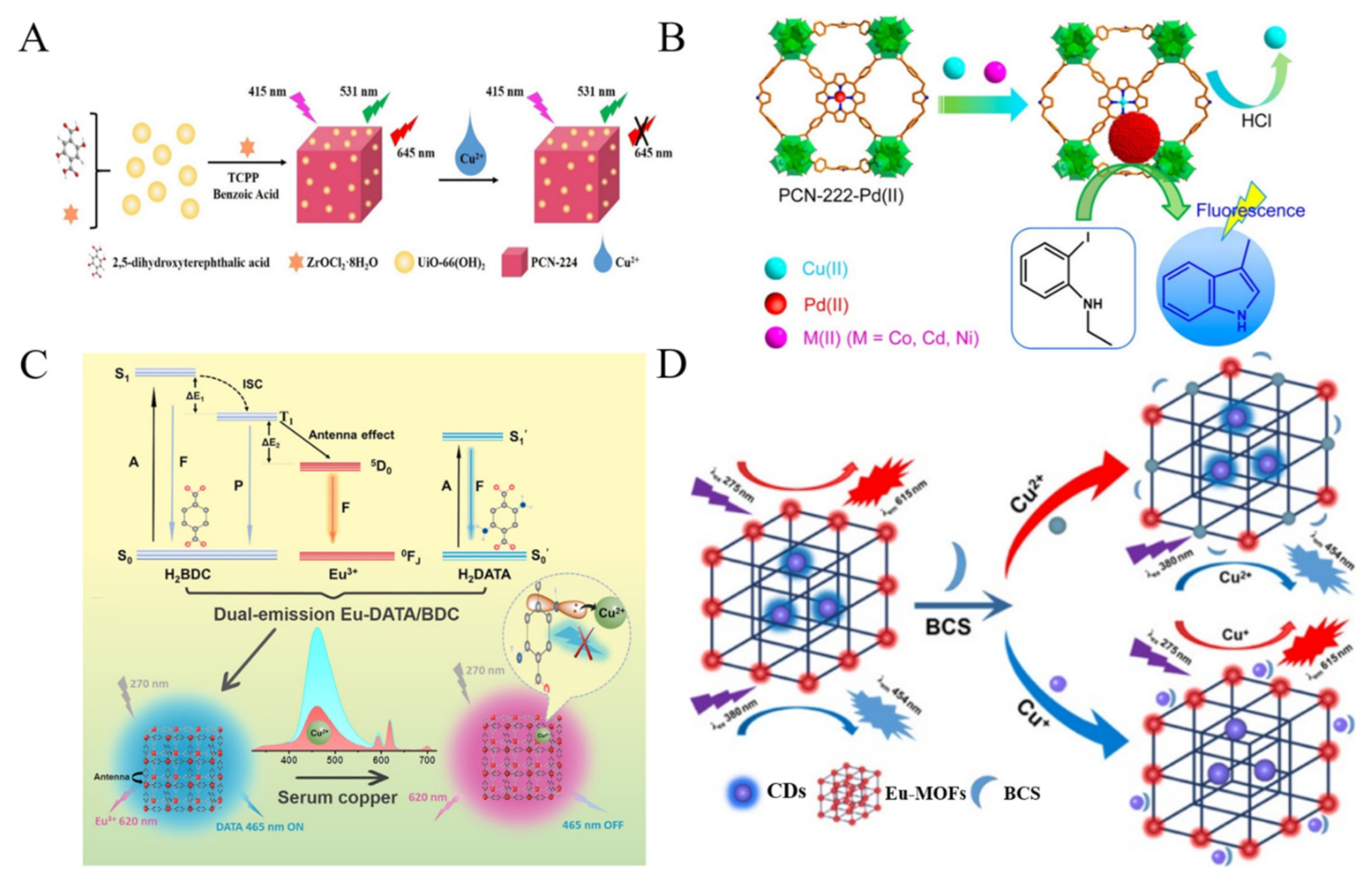
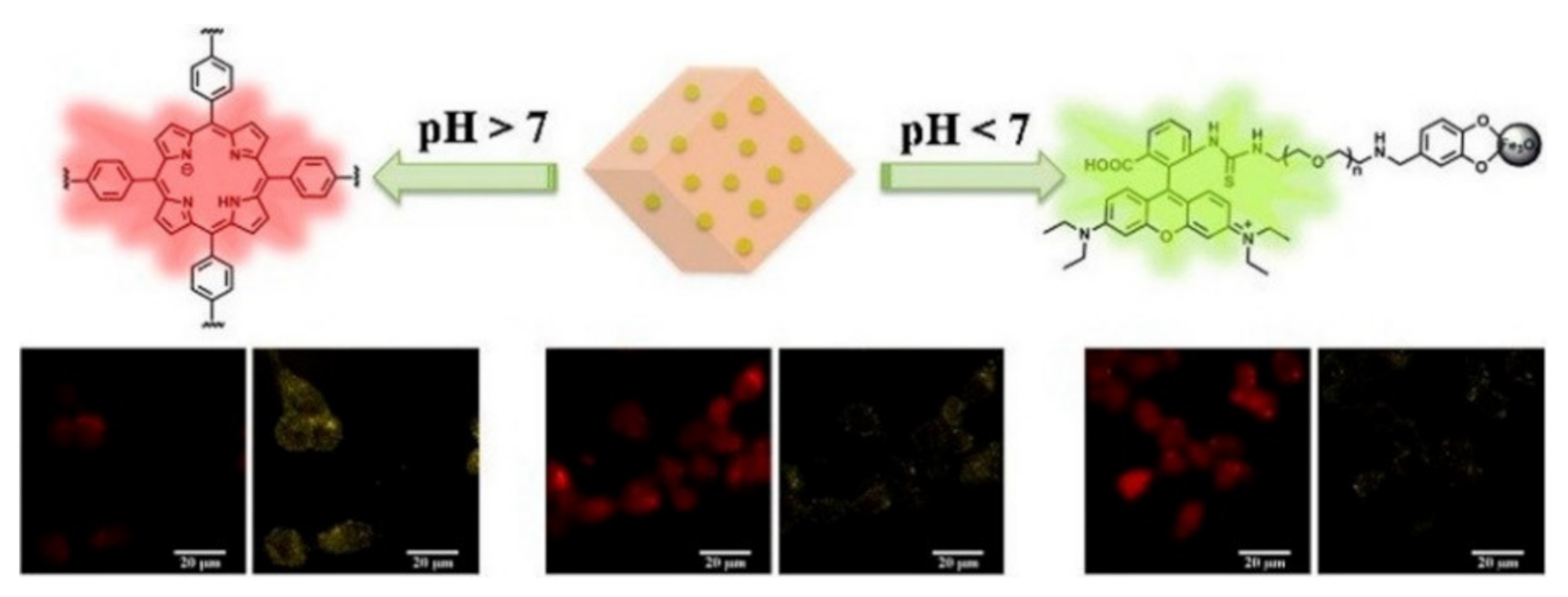

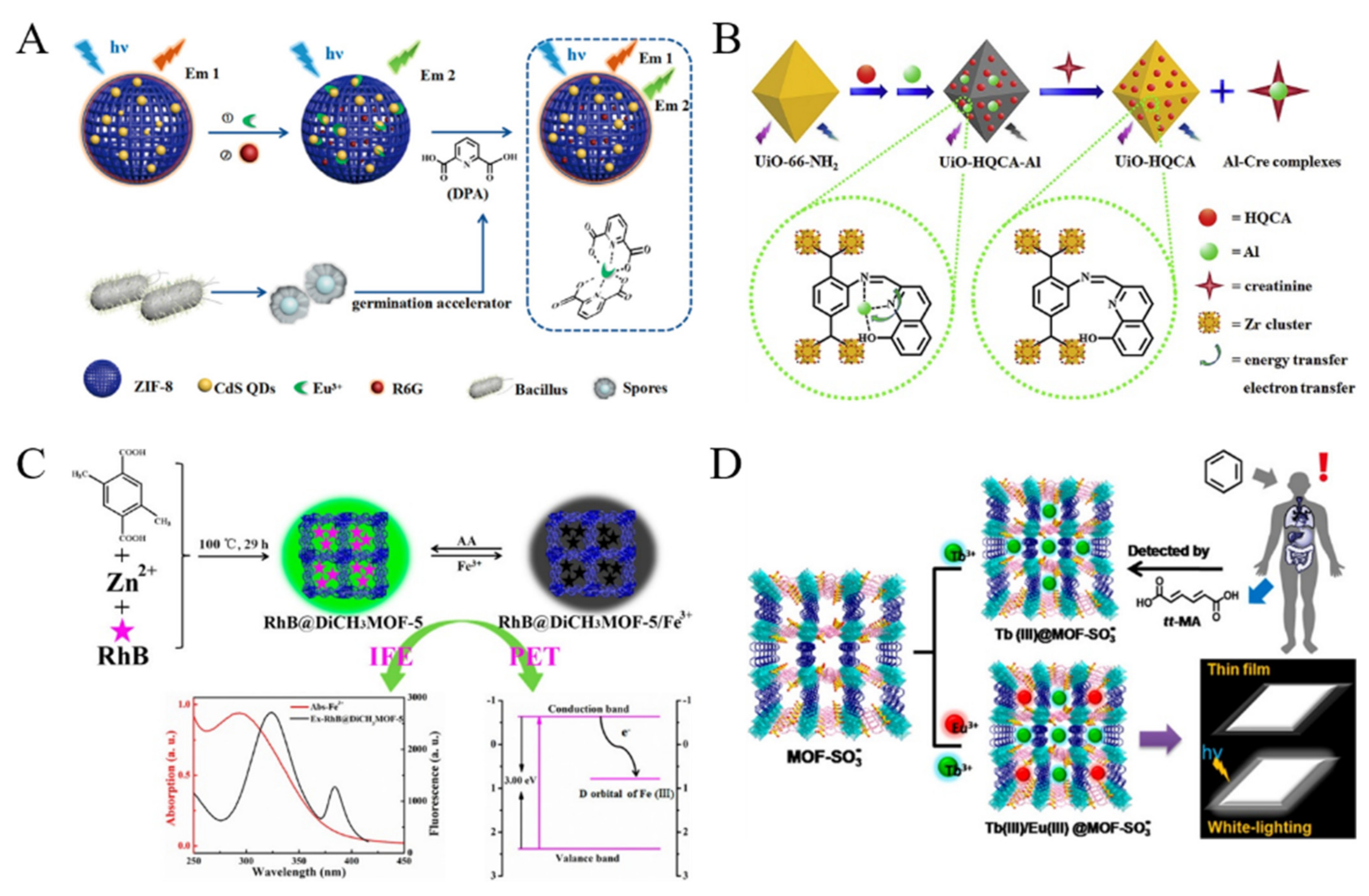
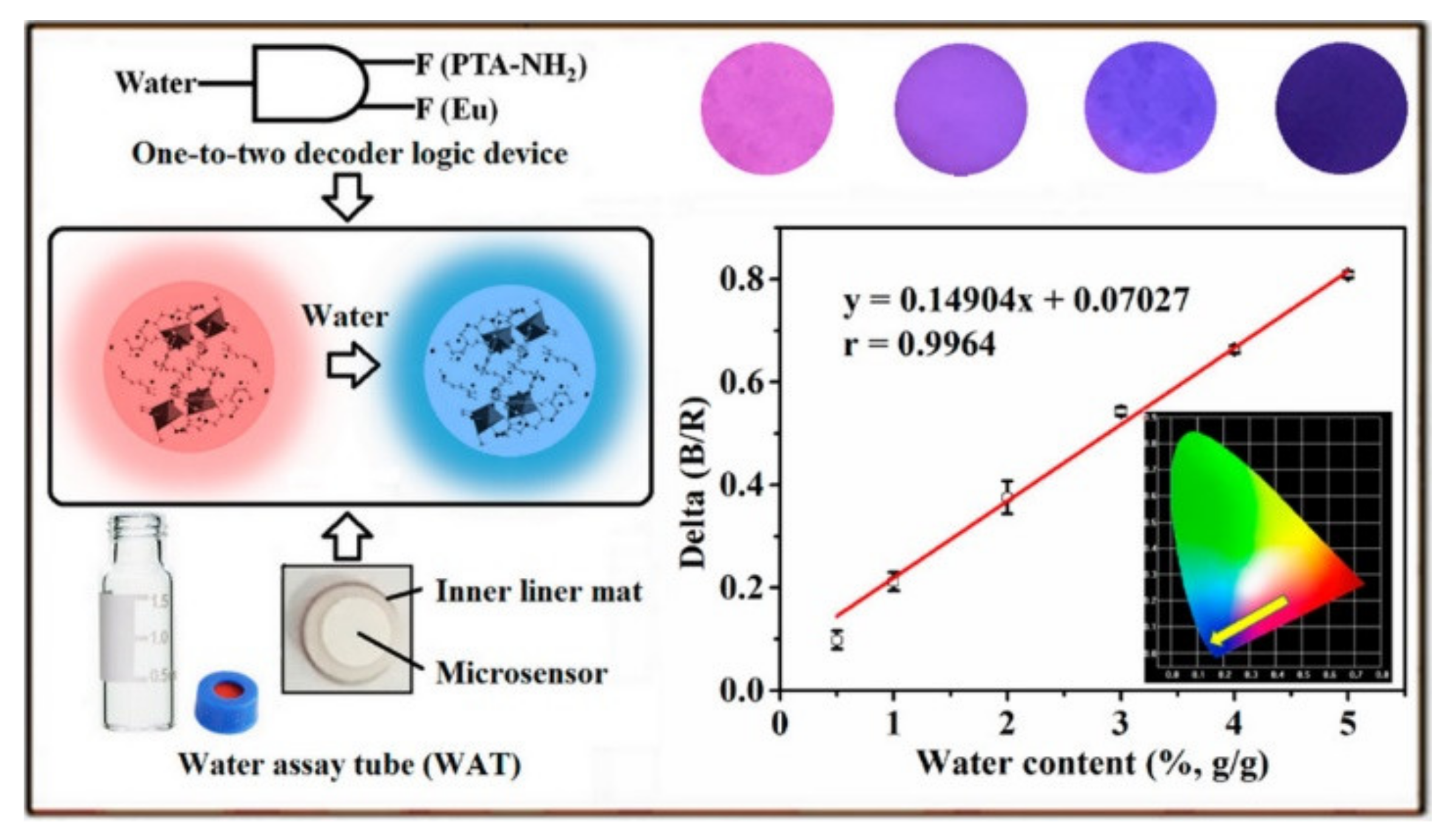
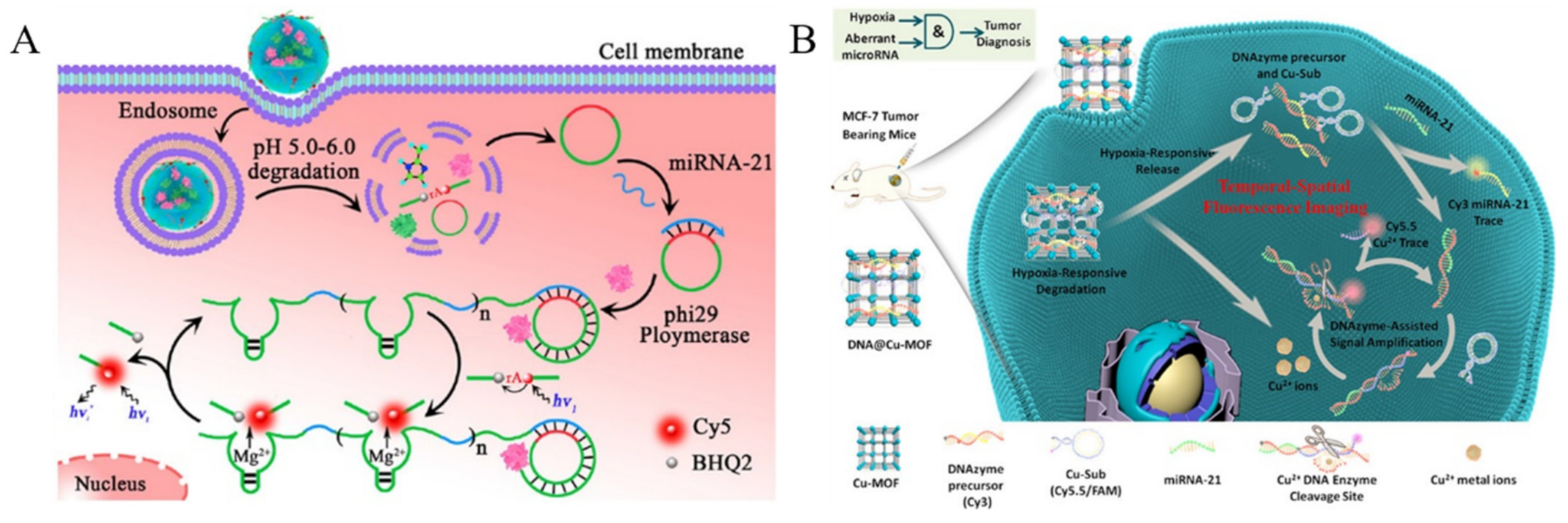
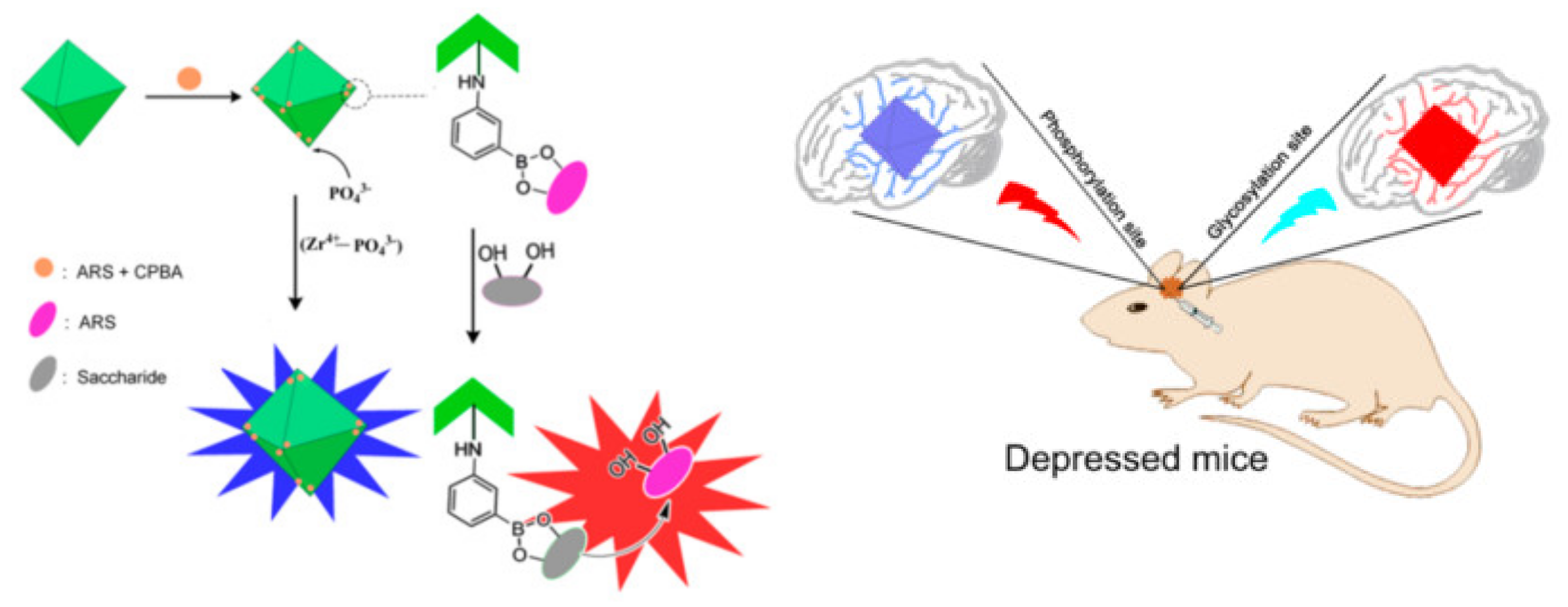
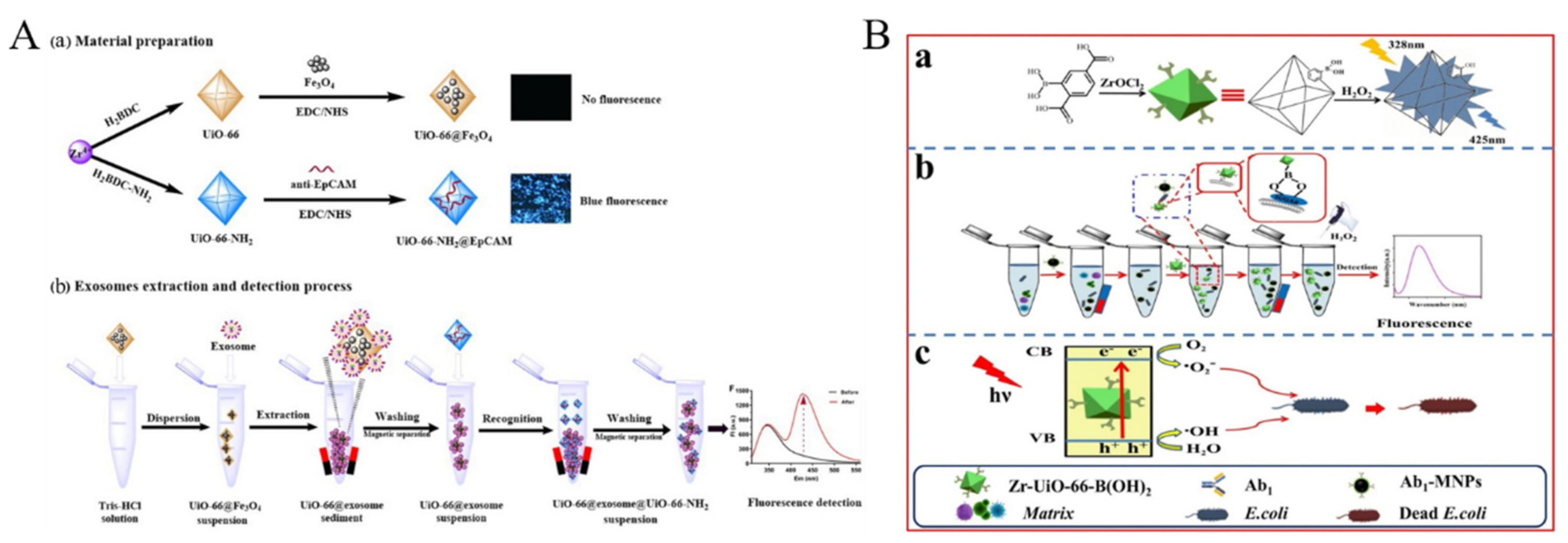
Publisher’s Note: MDPI stays neutral with regard to jurisdictional claims in published maps and institutional affiliations. |
© 2022 by the authors. Licensee MDPI, Basel, Switzerland. This article is an open access article distributed under the terms and conditions of the Creative Commons Attribution (CC BY) license (https://creativecommons.org/licenses/by/4.0/).
Share and Cite
Xia, N.; Chang, Y.; Zhou, Q.; Ding, S.; Gao, F. An Overview of the Design of Metal-Organic Frameworks-Based Fluorescent Chemosensors and Biosensors. Biosensors 2022, 12, 928. https://doi.org/10.3390/bios12110928
Xia N, Chang Y, Zhou Q, Ding S, Gao F. An Overview of the Design of Metal-Organic Frameworks-Based Fluorescent Chemosensors and Biosensors. Biosensors. 2022; 12(11):928. https://doi.org/10.3390/bios12110928
Chicago/Turabian StyleXia, Ning, Yong Chang, Qian Zhou, Shoujie Ding, and Fengli Gao. 2022. "An Overview of the Design of Metal-Organic Frameworks-Based Fluorescent Chemosensors and Biosensors" Biosensors 12, no. 11: 928. https://doi.org/10.3390/bios12110928
APA StyleXia, N., Chang, Y., Zhou, Q., Ding, S., & Gao, F. (2022). An Overview of the Design of Metal-Organic Frameworks-Based Fluorescent Chemosensors and Biosensors. Biosensors, 12(11), 928. https://doi.org/10.3390/bios12110928







